Francesca and Henk-Jan's Backpacking Trip!
Thursday, February 18, 2010
Intending To... Write
After a bumping (and slightly nauseating) sangthaew ride, we arrived at Doi Suthep around 1:00 PM. I pouted looking at the temple – we were going to have to climb up 300+ steps to get there! But we did it of course, and when we arrived at the top we were greeted by statues that at first glance we thought would be typical Buddha statues you always find at temples. However, the figure definitely did not resemble Buddha… more like Buddha’s evil cousin! With pointy “devil-like” beard and one of those “bandit” mustaches, these guys were decked out in pimp leopard-print jackets and some fashionable wooden bling. The temple itself was built during King Kuna’s period in the 1300’s, and contains relics that the King put inside the 10 meter high stupa on site. The temple was used and worked on throughout its existence – gaining its Naga-head staircases in the 1500’s and a restoration in the 1800’s.

They were doing restoration work on the temple when we got there, but they did a pretty good job of covering it up using a sparkly gold cloth – the same shade as the temple itself. We walked around peering at various gold Buddha statues, at one point making our way into one of the temples where a monk and his assistant were sitting. The monk was blessing people, while simultaneously tying their wrists with white cloth strings for good luck. After getting our blessing, we walked around the temple pavilion, getting a great panoramic look at the city landscape in the process. On the way back down to our driver, we stopped and debated over a really cute purple hat we had spotted on the way up. It seemed slightly big for me, but it was really cheap. While I wasn’t paying attention, Henk ran up the steps behind me and bought the hat! Here I am in my new purple hat!
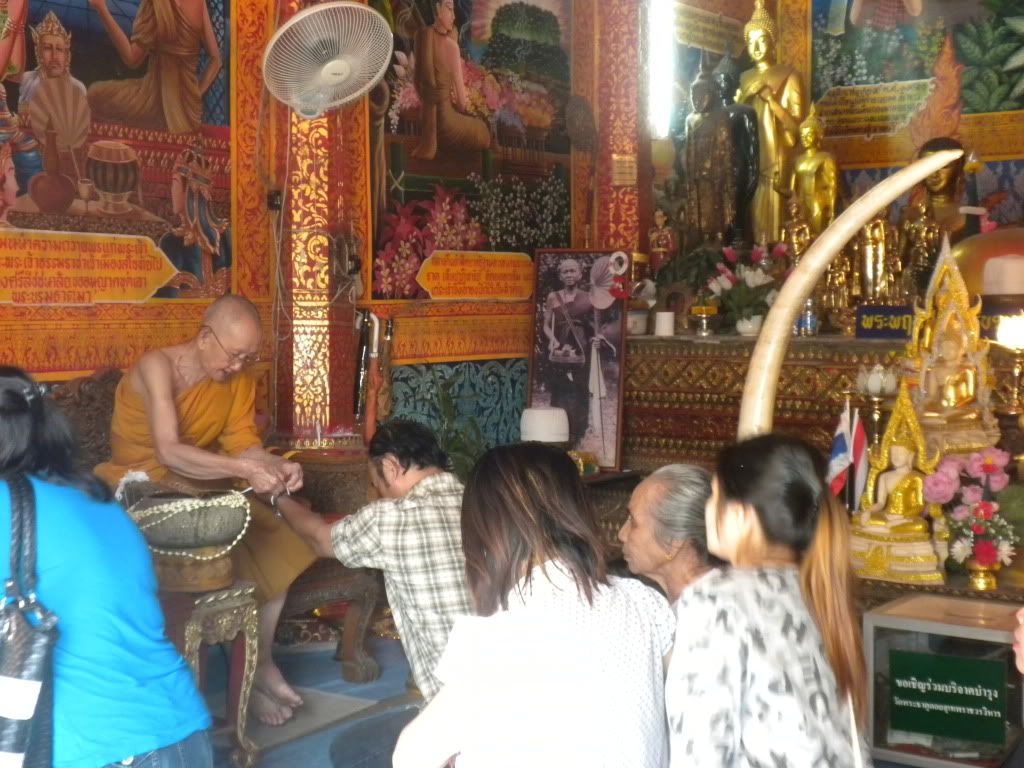
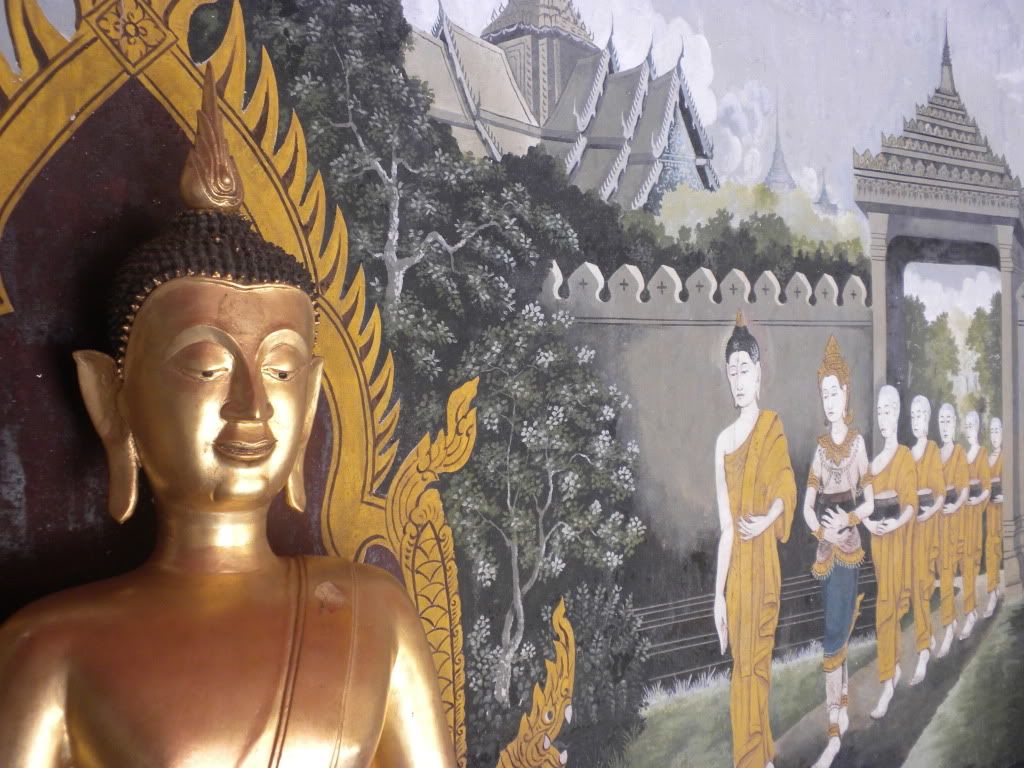
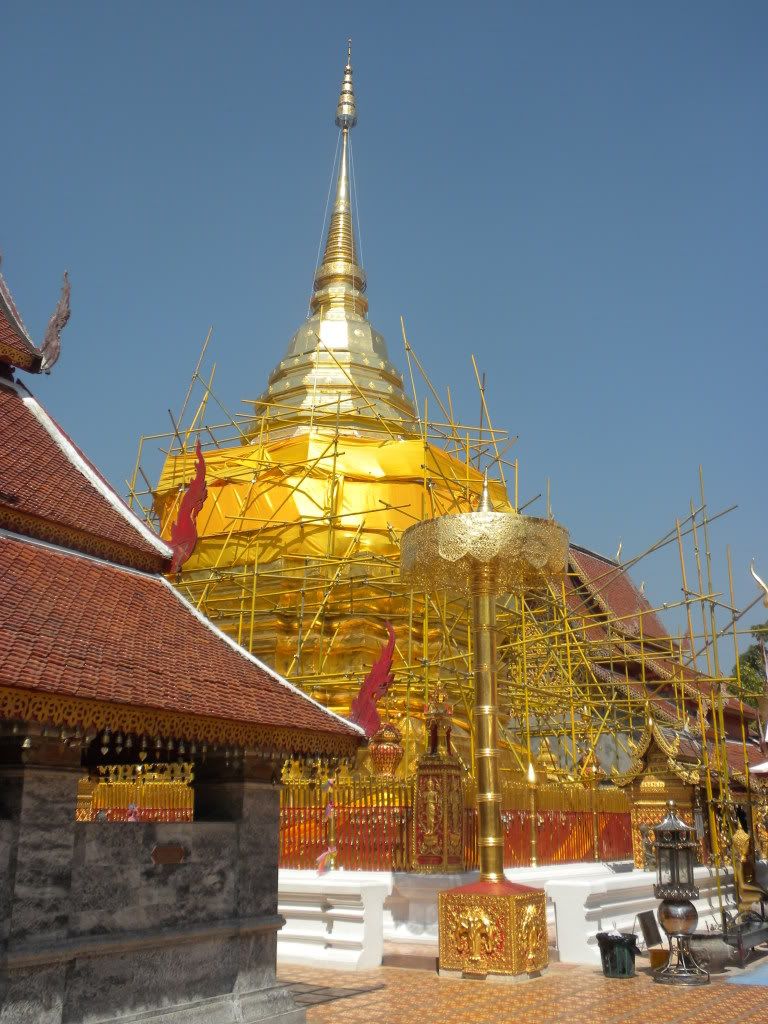
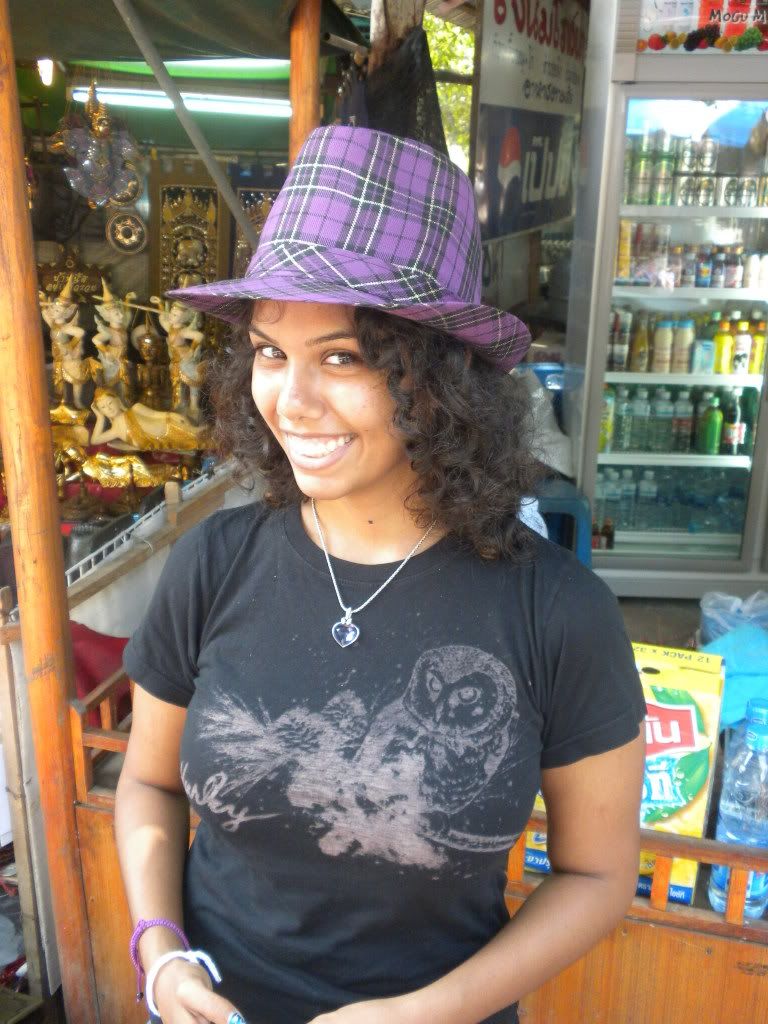
Next we rode towards the Winter Palace… also known as the Bhubing Palace which was built in 1961. This palace is sometimes closed to visitors when the King and his family come on a holiday. And WOW the palace grounds are gorgeous. We walked through countless varieties of flowers, including some huge and multicolored roses. Everything was so beautifully landscaped, which makes sense considering they had something like 50+ gardeners working on the place year-round. The “palace” itself was pretty modest – more like a large house. But with the surrounding scenery, I understand why the royal family wouldn’t want to build anything massive to take away from it. We continued along the path to some awesome fountains built for the Queen, plus another little house up on a flower covered hill. After stopping to grab an orange juice and marveling at the giant bamboo plants, Henk and I found our ride and he took us to our last stop of the day: the Hmong market.
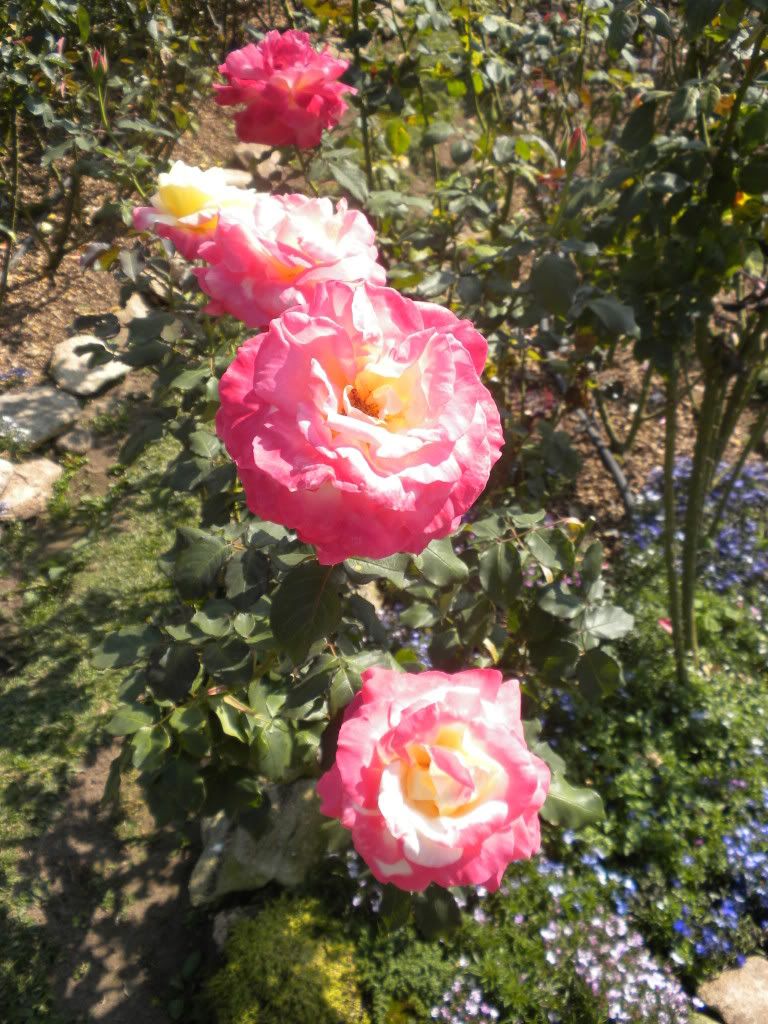
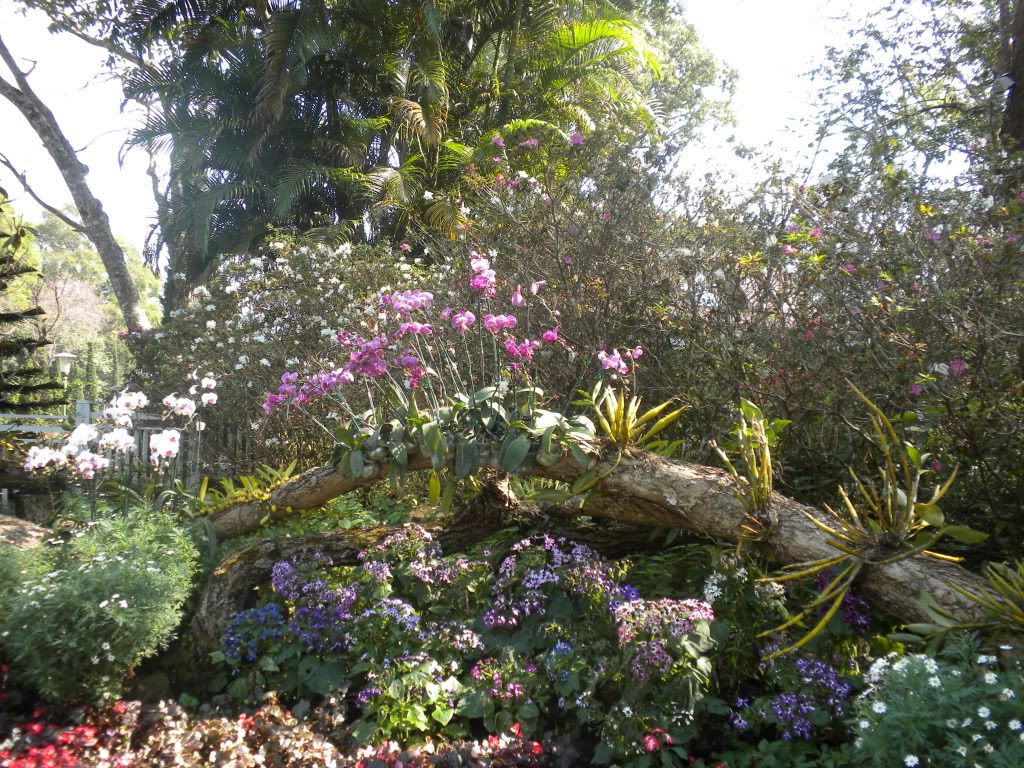
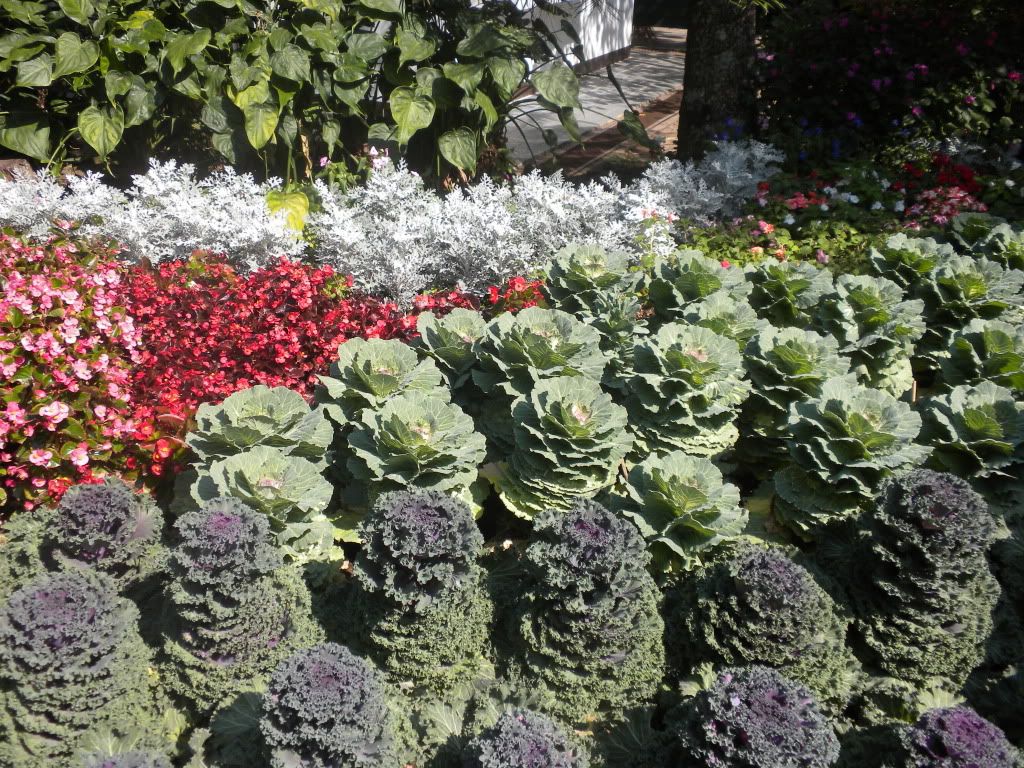
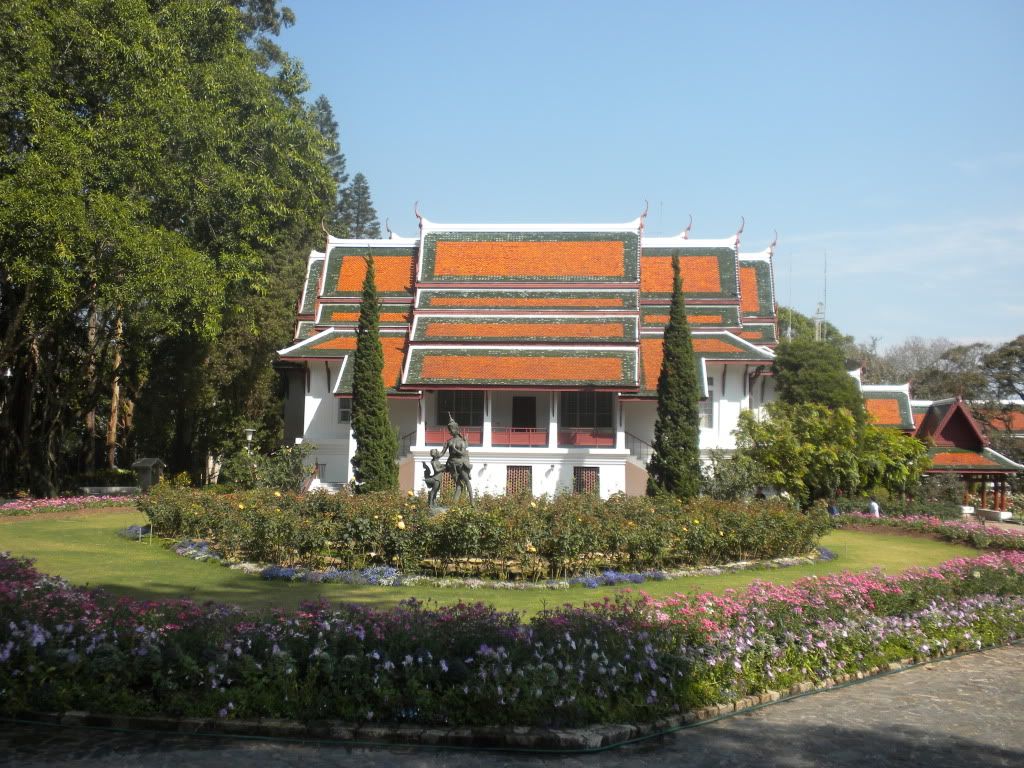
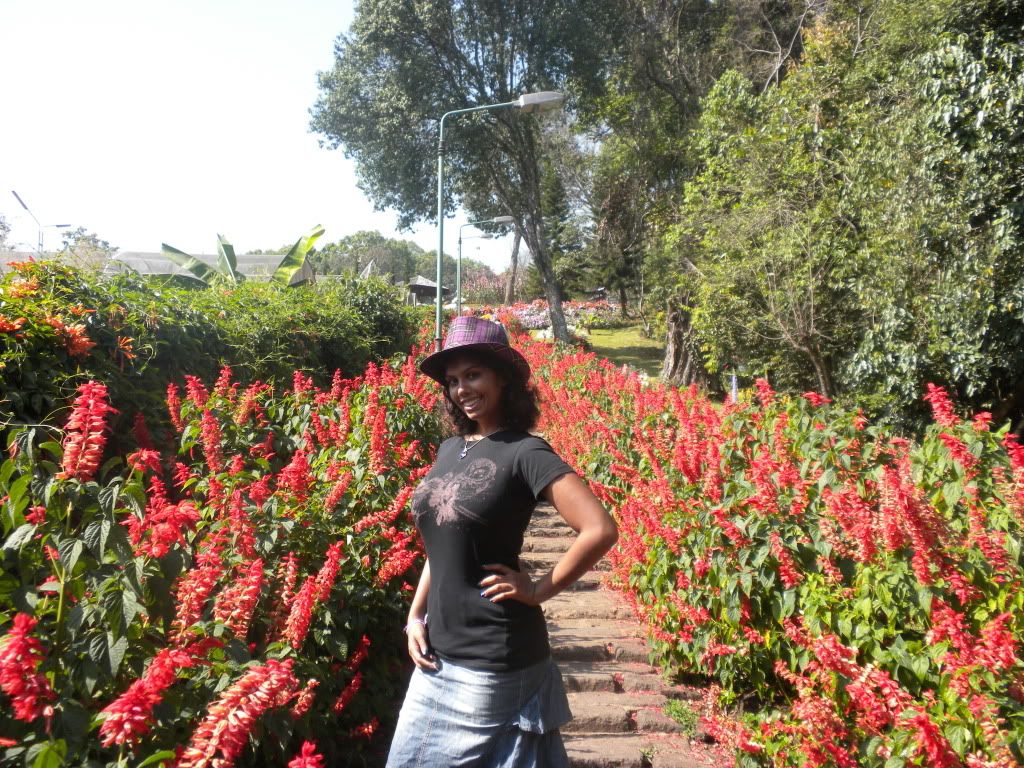
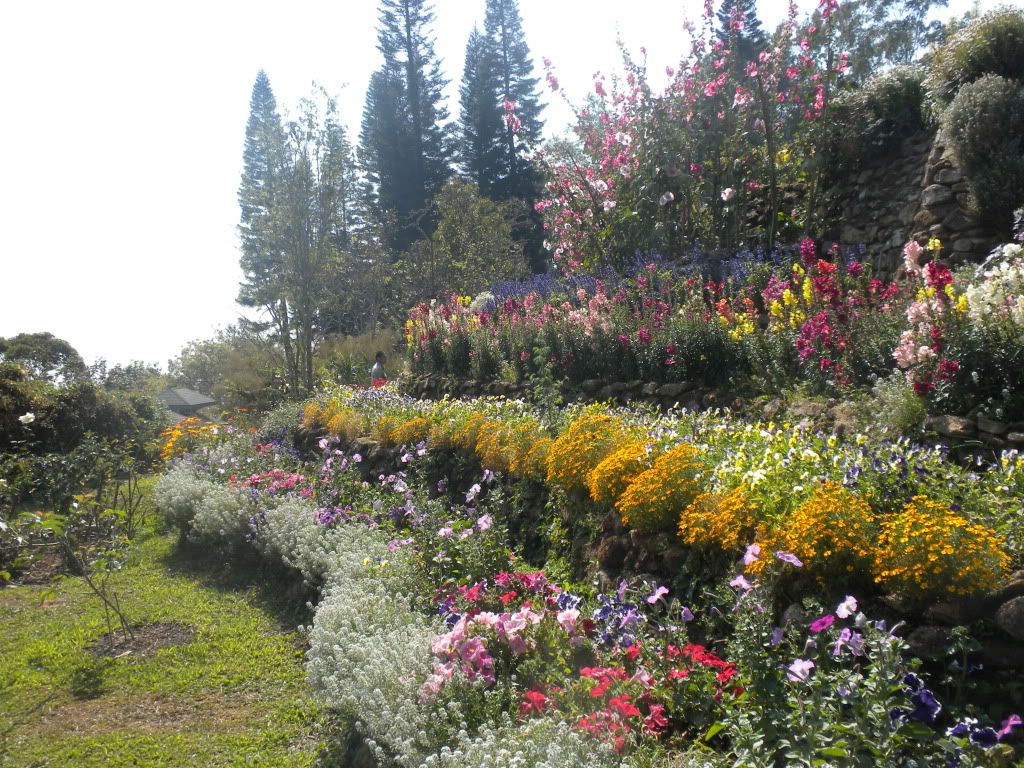
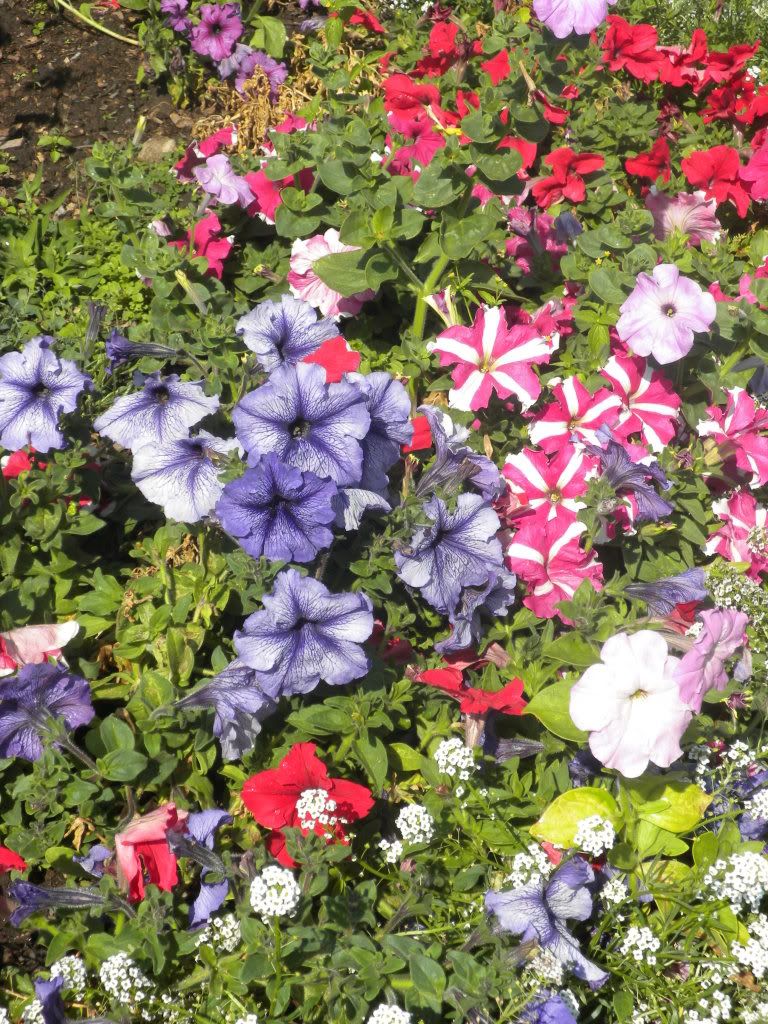
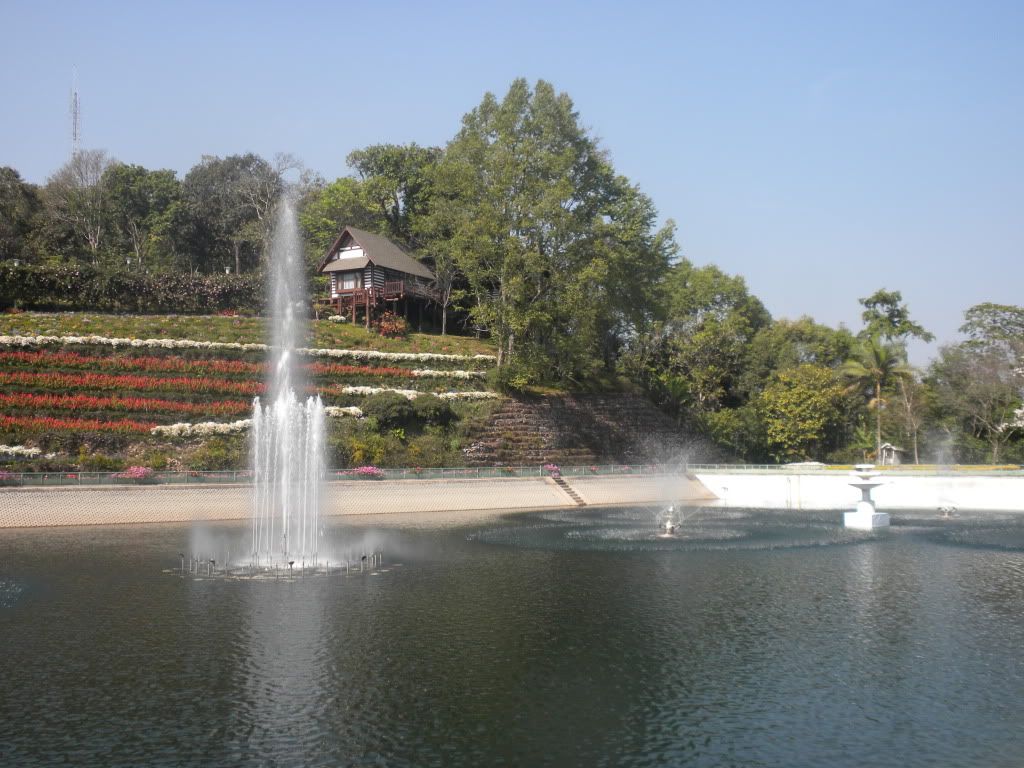
Well visited, this market is run by the Hmong (or Mong) hill tribe people, who are found in northern Thailand as well as neighboring Laos and Vietnam. We explored the little village, which was completely swarmed by typical Chinese-made market goods, and managed to find a small house with some strange-looking preserved animal fetuses in jars. After that we found the small Hmong Hilltribe Museum which explained a little about the Padong longneck women’s rings and the opium trade the Hmong used to partake in. Later on in our travels, Henk showed me a picture that he found in a hilltribe book that explained how the opium is harvested. Turns out a three pronged scraper is used to make three gashes in the opium bud. Next the semi-liquid substance begins to run out and is collected and dried by the opium grower. Hmm… take a look at our picture of the poppies growing in this Hmong village. Looks like they still might be harvesting a little opium here!

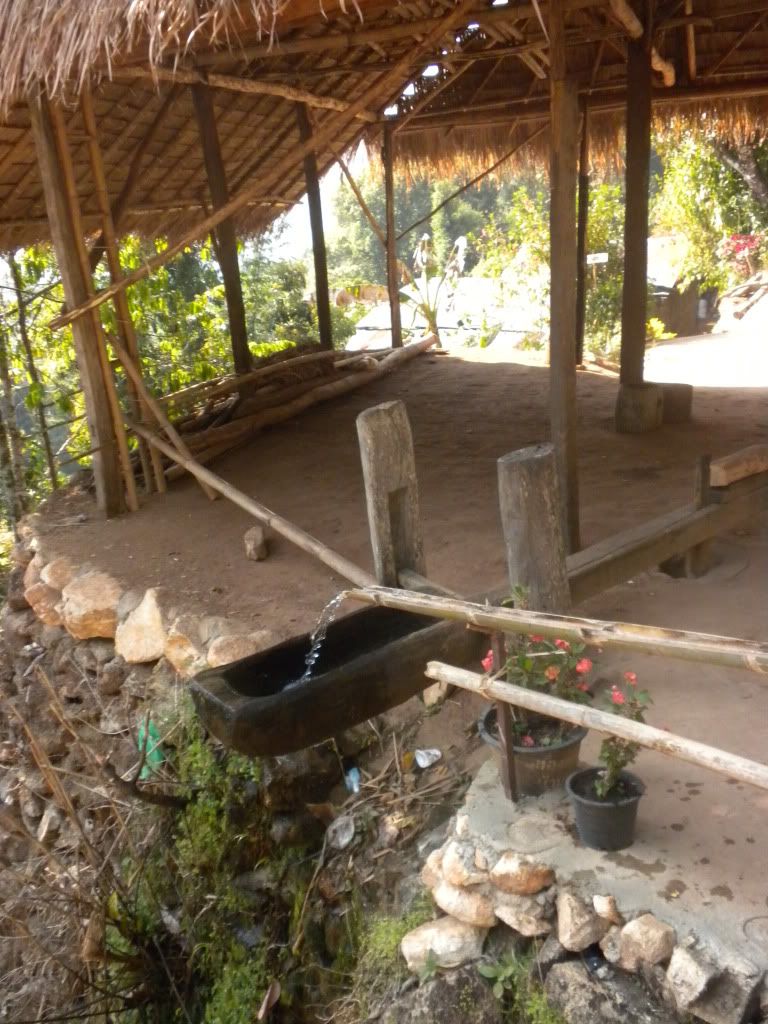
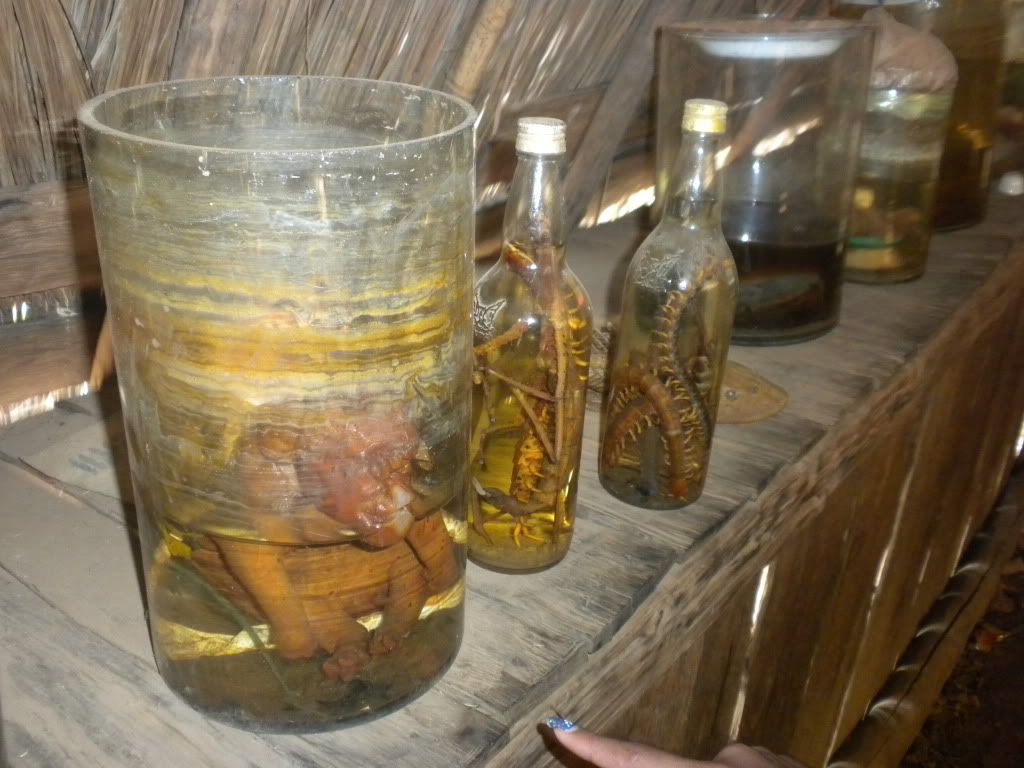
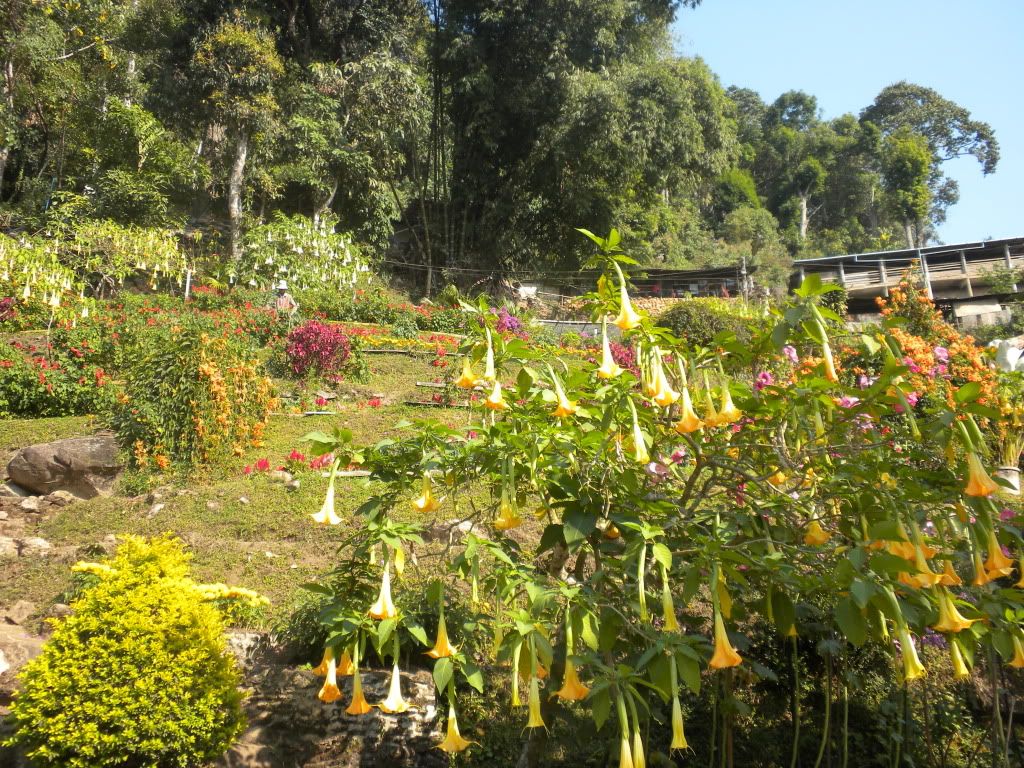
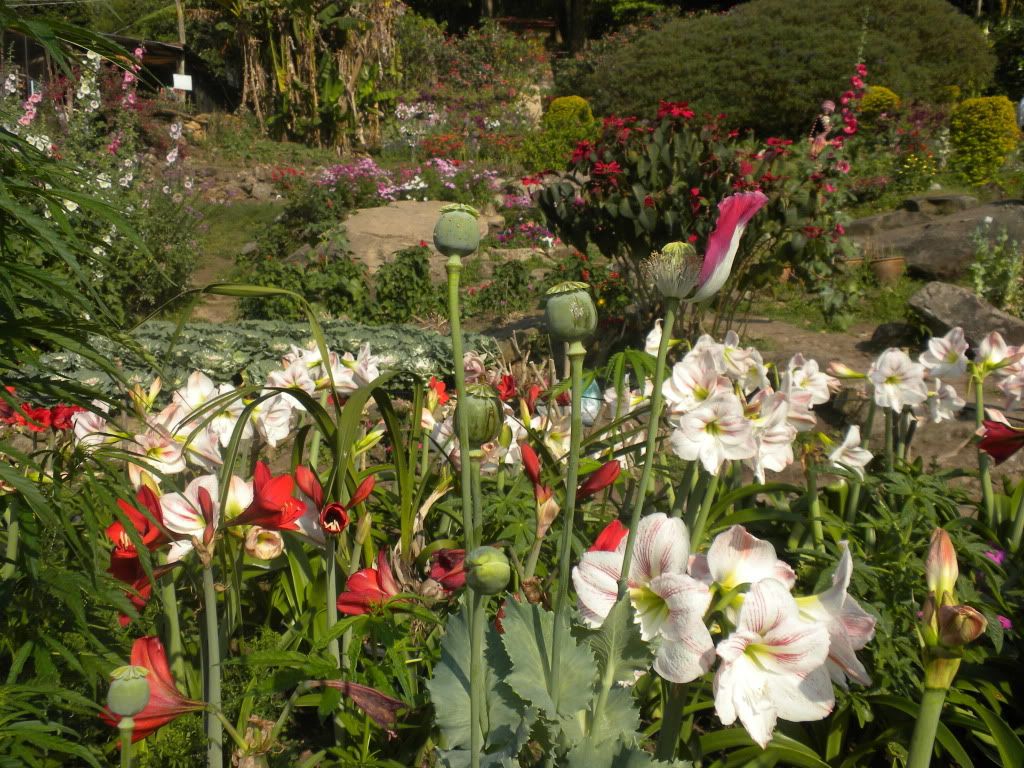
It was after 4:00 PM when we returned back to the Old City. Badly needed to relax, we ordered a pizza and watched some Simpsons. We had a special event planned for the next day: Monk Chat’s meditation retreat! On the 16th we headed to the University with the hopes that there would still be space for the weekly retreat. Since we didn’t have any purely white clothes (and white clothes are mandatory for the retreat) we purchased some from the monks signing us up. Next we made our way into a side room for a talk on Buddhism from one of the resident student monks. His talk was long and detailed, so let me summarize the basics for you here:
Buddhism is both a religion and more importantly a “way of life” or a set of guidelines for achieving peace and happiness in one’s life. It teaches that for every action, there is a reaction – and that by doing good actions or bad actions, one will achieve an equally good or bad reaction. Thus the first step to inner peace is acknowledging this fact and proceeding to make only “good or right actions” which consist of (from an online website on Buddhism):
1. Right View- To understand wholesome deeds, unwholesome deeds and comprehend the law of Karma.
2. Right Intention- The intention of non-greed, non-hatred and non-delusion.
3. Right Speech- Abstaining from false speech, malicious speech, harsh speech and idle chatter.
4. Right Action- Abstaining from killing, stealing and sexual misconduct.
5. Right Livelihood- Abstaining from wrong and corrupt means of livelihood.
6. Right Effort- Awakening zeal for abandoning of unwholesome states and arising & sustaining of wholesome states.
7. Right Mindfulness- The four foundations of mindfulness (satipattana) namely contemplation on body, contemplation on feelings, contemplation on mind and contemplation on mind-objects.
8. Right Concentration- Abandoning of five hindrances namely lust, ill-will sloth-torpor, worry-agitation and doubt through jhanas.
It was now that we also learned about the two types of meditation: Concentration meditation and insight meditation. First one must learn concentration meditation, which involves controlling one’s body and mind from wandering and “acting without thinking.” By practicing this type of meditation, one is force to focus on every action they take and exactly what they do. Next one can learn insight meditation. This more complex (and probably interesting) form of meditation teaches you how to control your emotions. Once you can control your mind with concentration meditation, then you can control your feelings/emotions with insight meditation. This is the point most people wish to get to – to be able to worry less, fear less, feel less sadness, and just be more content and find more happiness with their current life.
After this talk, we were then brought to the meditation retreat center for the evening. Here we changed into our white clothes and wandered around the grounds to take some pictures. Dinner was a vegetarian meal of pad Thai, bamboo shoots, and slices of watermelon for dessert. Before we could sit down and eat however, we had to perform a Buddhist chant which explained that we were not eating for pleasure but merely to nourish our body. Didn’t sound like much fun, but I repeated it quickly because I was pretty hungry by then! Once dinner was over, we were called by the bell to our first meditation session. We were taught how to meditation through sitting, walking, and lying down. We were even taught how to stand up “mindfully.” With everything we did, we had to take great care to notice our actions – no matter how small – in what we did. Here is a great description I found on the House of Dhamma website that explains what we learned (just browse this unless you want to try it):
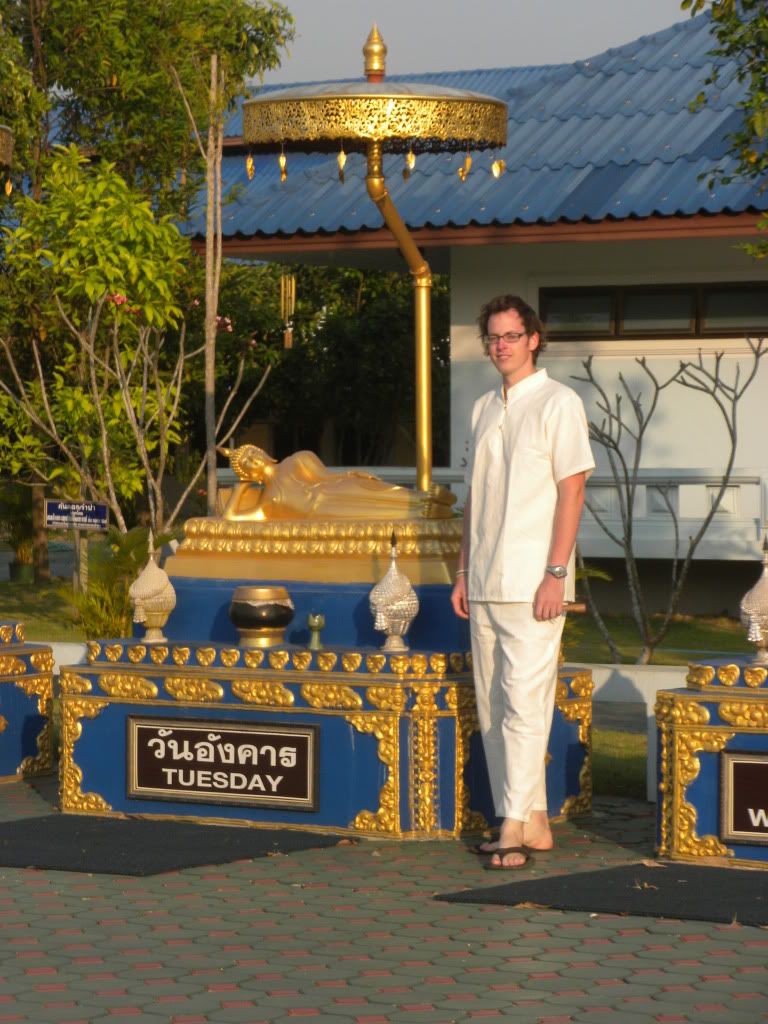
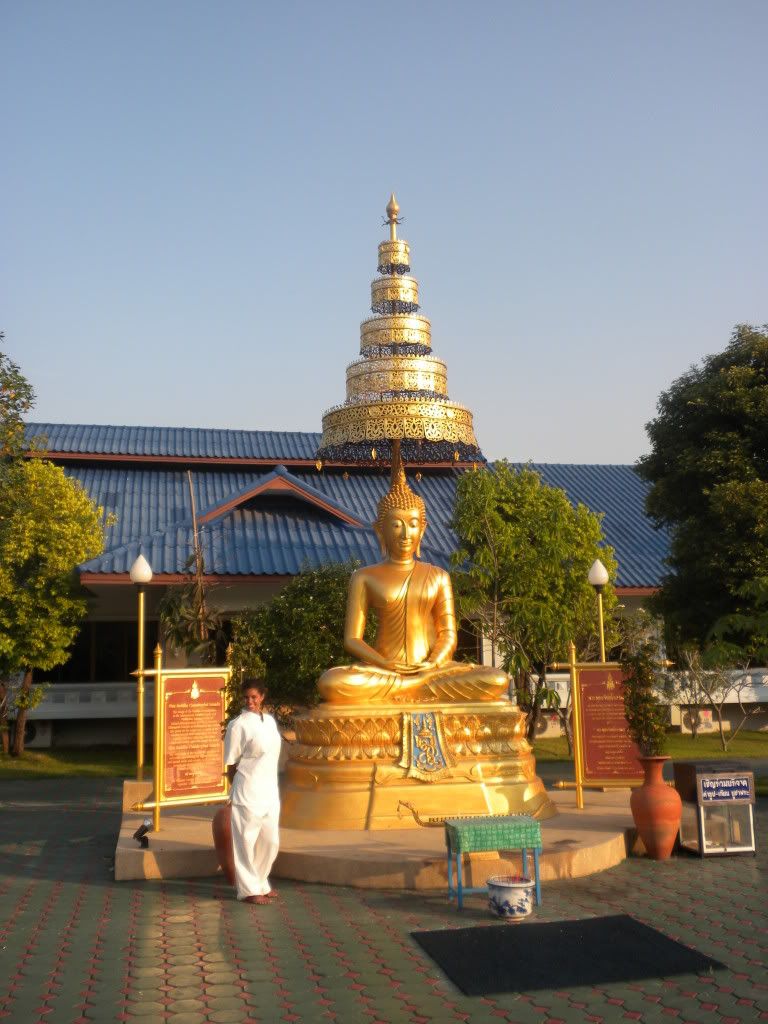
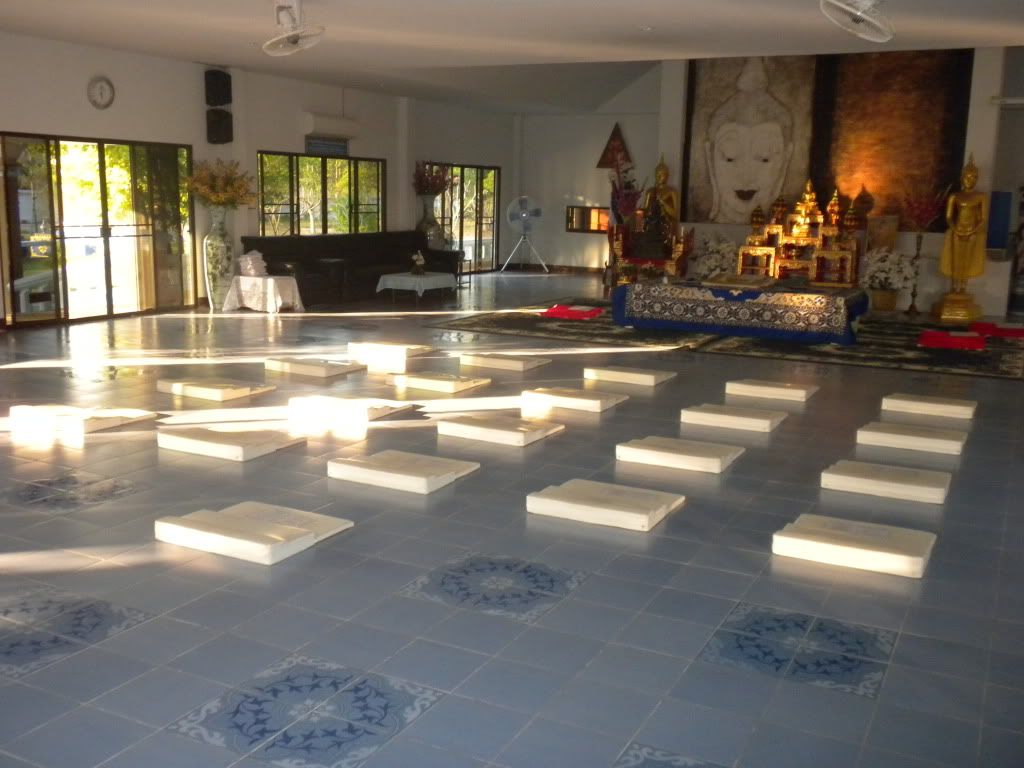
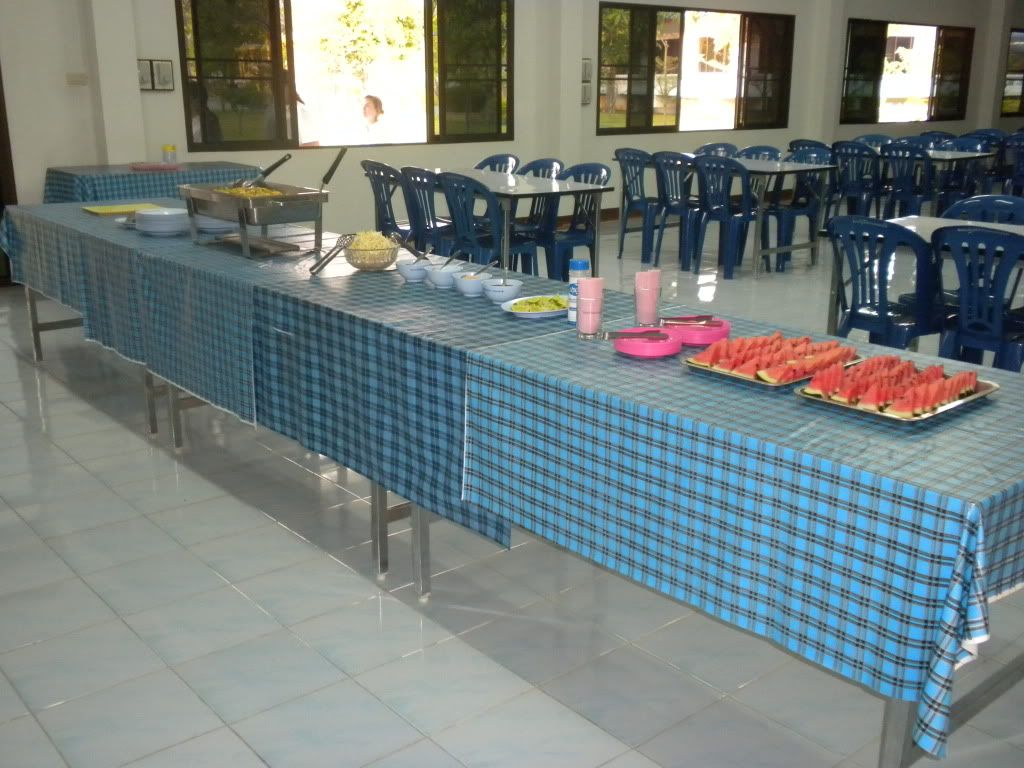

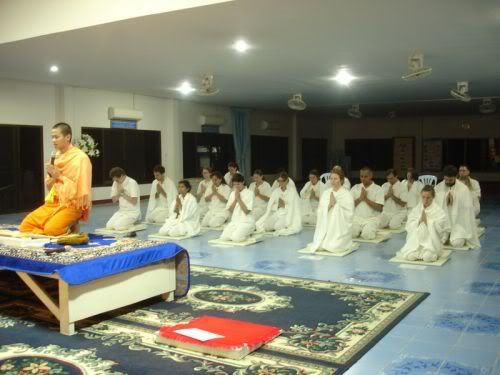
For Sitting Meditation:
“If a sound occurs, put your attention on your ears, acknowledge the sound; 'Hearing, hearing, hearing'. You may need to make three, five, ten or more acknowledgements until the sound dies away by itself or until it no longer disturbs you. Then very gently bring your attention back to the rising and falling. If your attention 'follows' a sound, at the point when you become aware of what has happened, acknowledge it 'Knowing, knowing, knowing' and then gently direct your attention back to the movements of the abdomen. Similarly if there is a smell, acknowledge it 'Smelling, smelling, smelling'.”
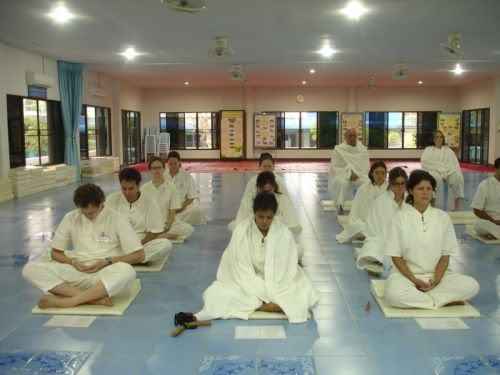
For Walking Meditation:
“You will need between ten and fifteen feet of space in which to walk. Stand still with your eyes open. You should be looking at the floor ahead of you. When standing still your gaze should be focused about two meters ahead of you, but when walking, the focus point should be a little nearer, about six feet ahead. Hold your hands together in front or behind you. Try to be aware of the position of the body standing and of any tension within it. The aim is to become fully aware of the present moment. To help you focus on the present moment, make three mental acknowledgments 'Standing, standing, standing'.
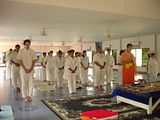
Next the practitioner should become aware of the intention to walk, again making three mental acknowledgments 'Intending to walk, intending to walk, intending to walk'.
Move your point of attention to the right foot. Lift it and move it forward and put it down about six inches ahead of the right. Be aware of the movement as it is happening and simultaneously acknowledge in mind 'Right goes thus'. The acknowledgment and the movement should coincide. Then repeat this with your left foot, switching to ‘Left goes thus.’ Continue walking, with awareness focused on the movements of the feet until you come to the end of your walk space.”
During Walking Meditation: Turning
“Be mindful of standing as before. Make three mental acknowledgments of the body standing. Then putting attention on the feet, try to be aware of the tension there as you become aware of the desire to turn. Make three mental acknowledgments 'Intending to turn, intending to turn, intending to turn'. while, at the same time, being aware of the intention to turn.
Next, turn to the right. Move your right foot clockwise. Lift the toes of your right foot keeping the heel on the ground, acknowledging (at the same time) 'turn' and as you put your toes down, acknowledge '-ning'. The angle of the movement should be about 45 degrees.
Lift your left foot straight up about three inches from the ground, saying in mind 'Turn'. Then place it parallel to the right foot, acknowledging '-ning'.
Make four pairs of these foot movements to complete a 180% turn. Note that the right heel revolves on the same spot throughout the exercise.”
Anyways, as you can tell the whole process is quite tedious. We had a break for a few minutes (for tea and cookies!) in between our two hours of meditation that night. However, after dinner we had clipped cards to our shirts proclaiming we were now in a “silent retreat,” meaning we weren’t allowed to speak to anyone until the next morning after lunch. Sadly, they didn’t allow couples to stay together at the retreat so Henk and I had to have rooms right next to each other but alone. Really exhausted, I fell asleep only to wake up the next morning to the 5:00 AM gong going off! (Hey, it is still better than the famed 3:00 AM rooster wake-up call.) Back to the classroom we went for more meditation practice. This time, we got to try our hand at some morning exercises: yoga!

At 7:00 AM we had a break for alms-giving to the monks. Monks are not allowed to cook for themselves, and they reason that because they nourish the people’s minds, the people should in exchange nourish their bodies by cooking for them. Monks walk around with little bowls every morning to collect food for their breakfast and lunch from the common people. We each grabbed a small bowl of rice to offer and stood in a line to spoon it into our monk’s bowls, being careful not to touch the monks. Next we got to have our own breakfast of toast, rice soup, and oranges. I think the toast was purely for us Westerners benefit! After breakfast we had discussion time about our experience and any questions we had for the Monks.
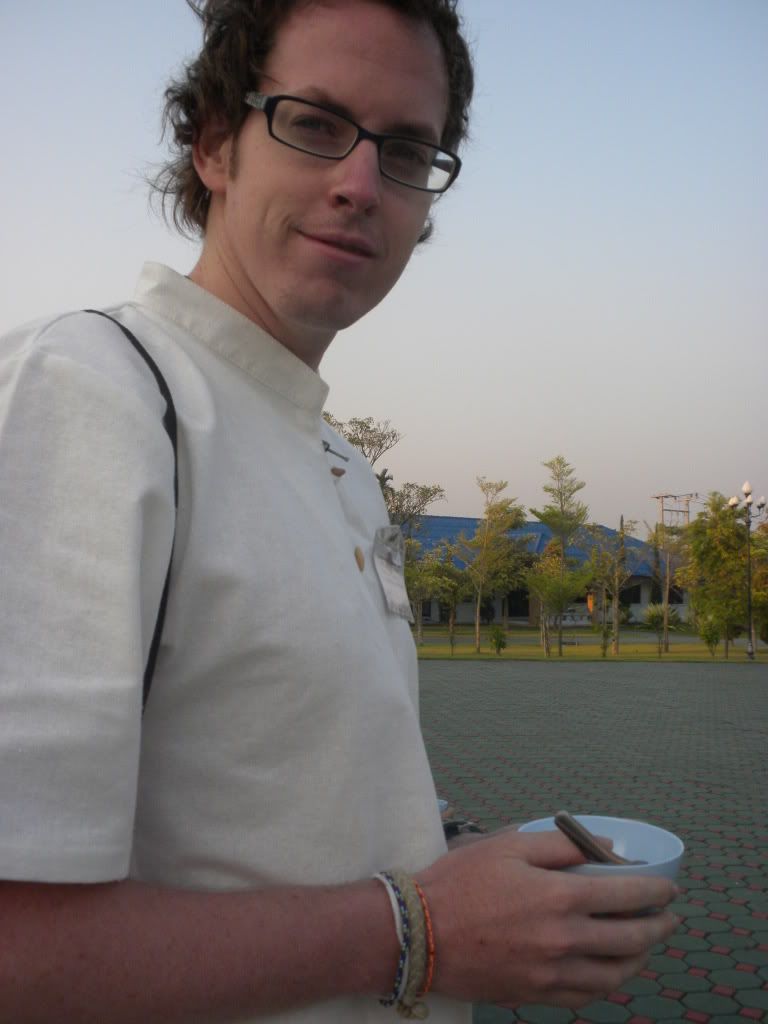
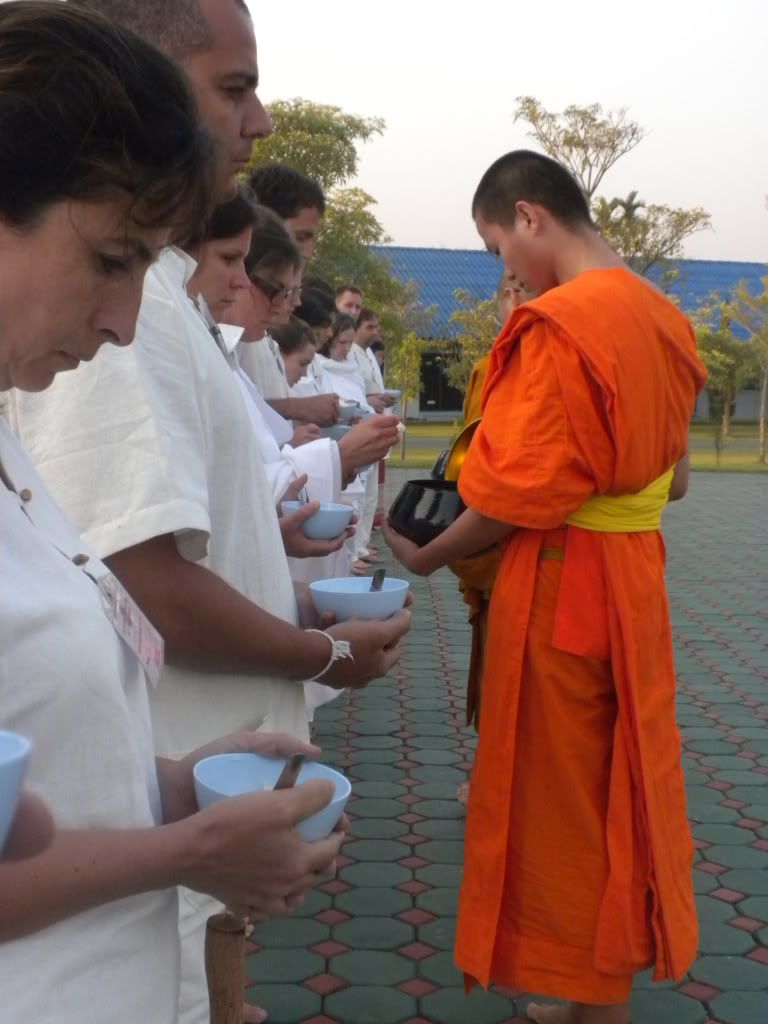
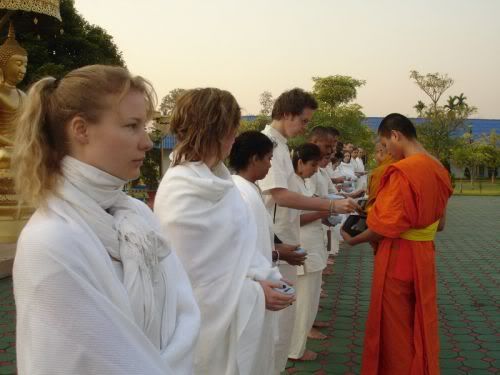
We sat outside in a circle and related our troubles meditation. Henk said he had trouble ignoring the pain in his back, and I explained that my legs kept going numb and distracting me. The Monks reiterated to us that our goal is to ignore, and eventually forget about, the pain. ‘But what if my legs start to fall off!’ I thought. The discussion was interesting and covered a wide range of topics we each asked about. An older monk told us a story during the discussion about how some Christian missionaries came to preach to a Buddhist monk, trying to convince him that they had the “correct” version of religious truth. They went on and on, talking to him for hours. The monk just sat there calmly. Finally the missionaries commented on how long the monk had let them go on for, thanking him that they weren’t kicked out right away and hoping they had convinced the monk of something pro-Christian. The monk simply smiled at them and said that it was fine… they helped him practice his listening skills! Funny!
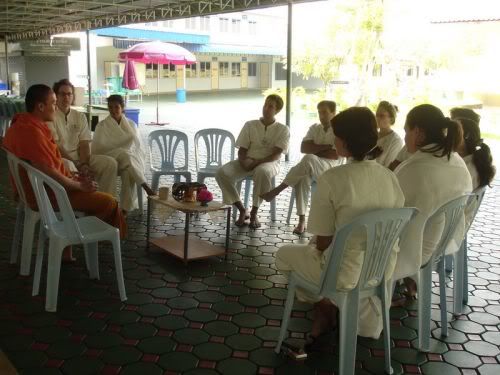
We then returned to the classroom for some practice meditating with beads. We closed our eyes, counting the beads silently in our heads. Breaking for lunch of Tom Yum, I noticed that one of the girls who was at the meditation retreat with us looked very familiar. And of course she did, as it happens I went to elementary school with her. After the silent retreat was over, we chatting for a little while and caught up. Turns out she is teaching English in Vietnam, and came to the meditation course with some friends. Such a small world! We returned to the hostel, surprisingly tired from the retreat and relaxed for the rest of the evening.
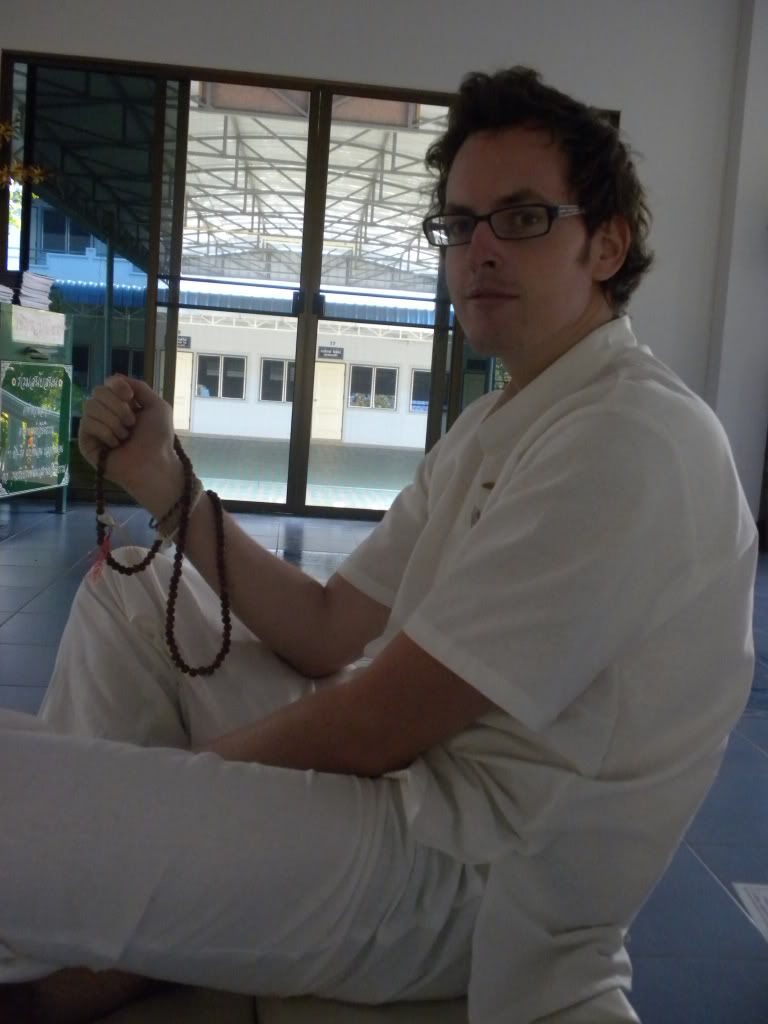
The 18th was also a big day for us. We had booked a day trip taking us out of the city to Chiang Rai, which by minivan is about 3 hours away from Chiang Mai. Picked up early, we arrived at a hot spring around 8:30 AM. We waited around while we had a banana-chocolate roti made for us for breakfast. Next was the main attraction for the day: the white temple, also known as the Wat Rong Khun. On our way to see the temple, we checked out the “world’s fanciest bathrooms,” which were temporarily closed. They were in fact quite decadent! Next was the Wat itself. From far away, the entire temple seemed to shimmer as if it was made of ice crystals. As we got closer, we noticed details that were lost far away: demon and human “hands” reaching out from a constructed “hell” below; various creatures that resembled goblins or monsters; dragons (nagas) and of course the Buddha image. Upon entering the temple, we noticed some of the “unique” murals on the walls. There was Spiderman! And Batman! And even Neo from the Matrix. Quite amusing, even to the Monk behind us laughing away at his first sight of the images.
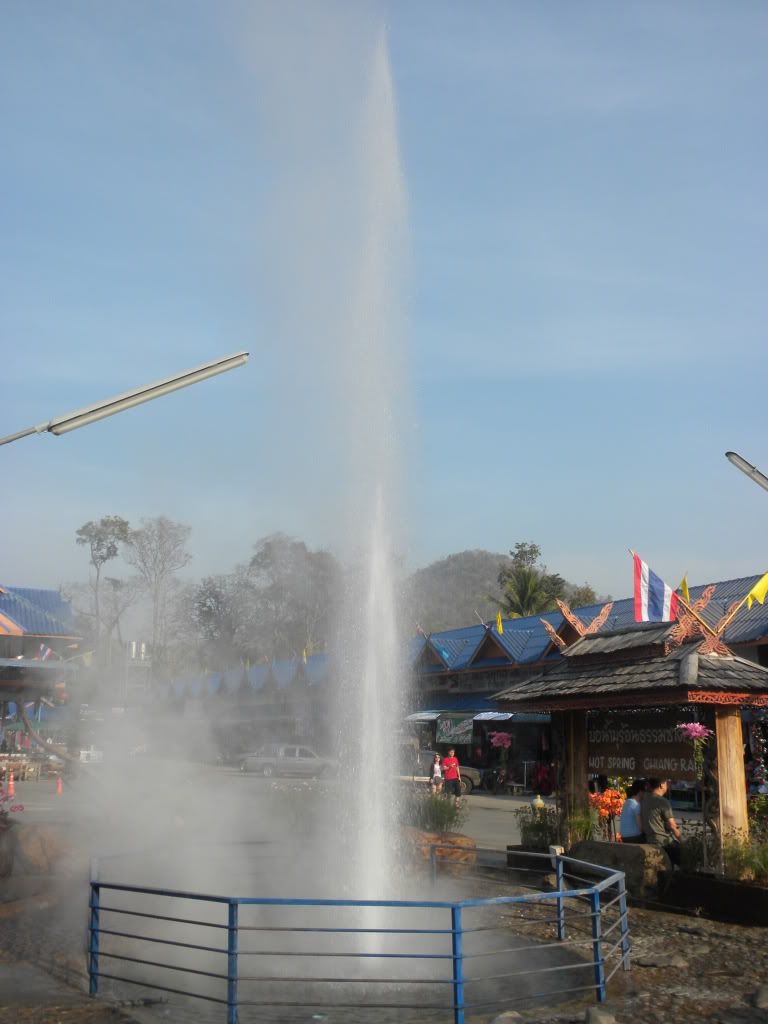
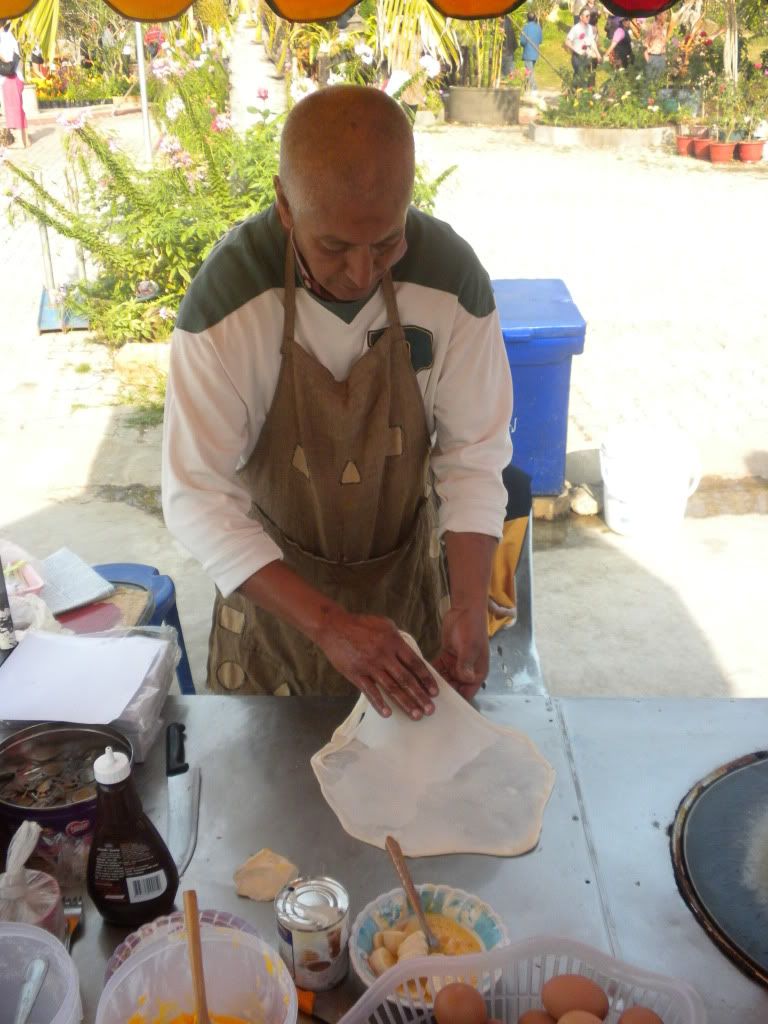
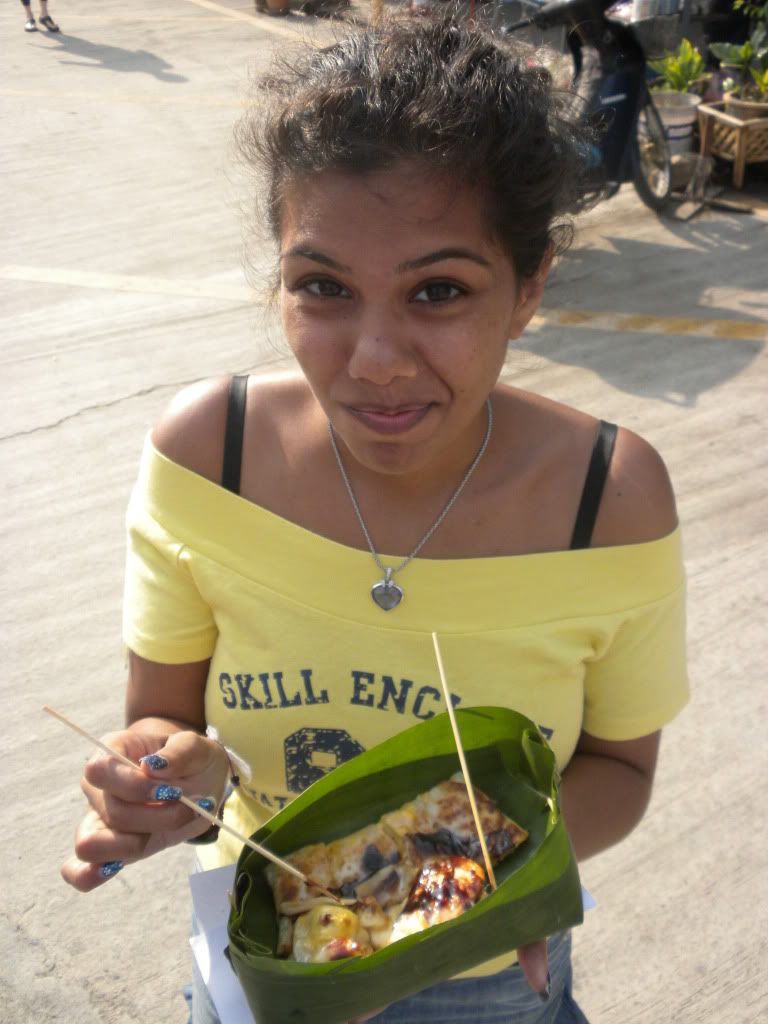
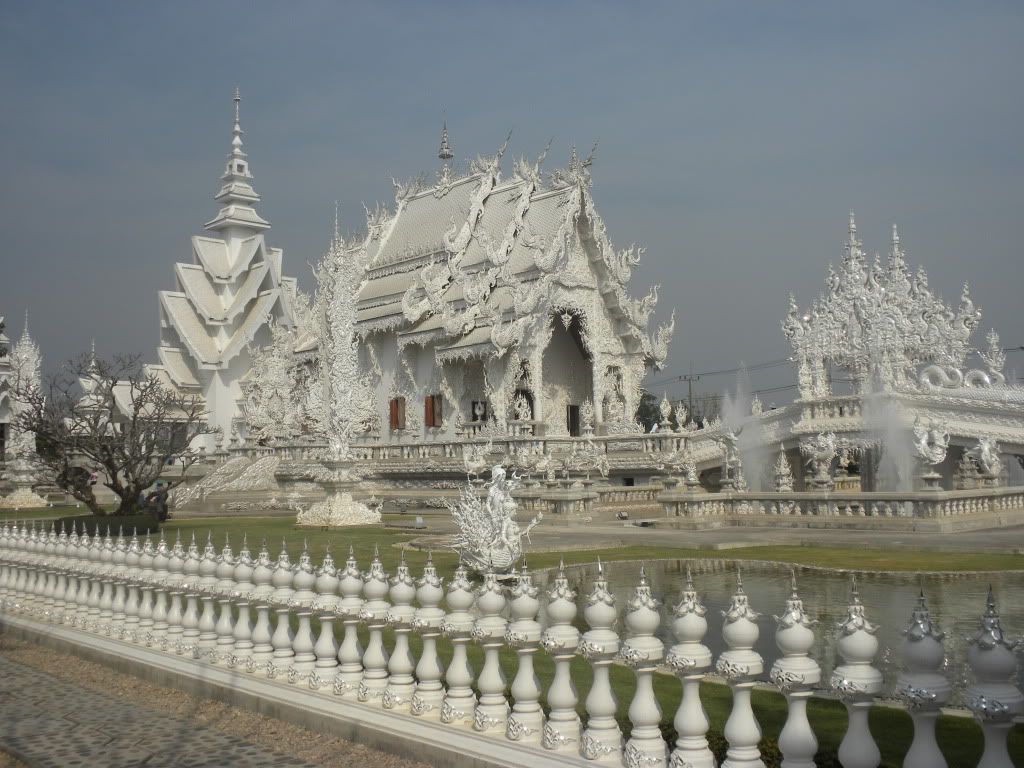
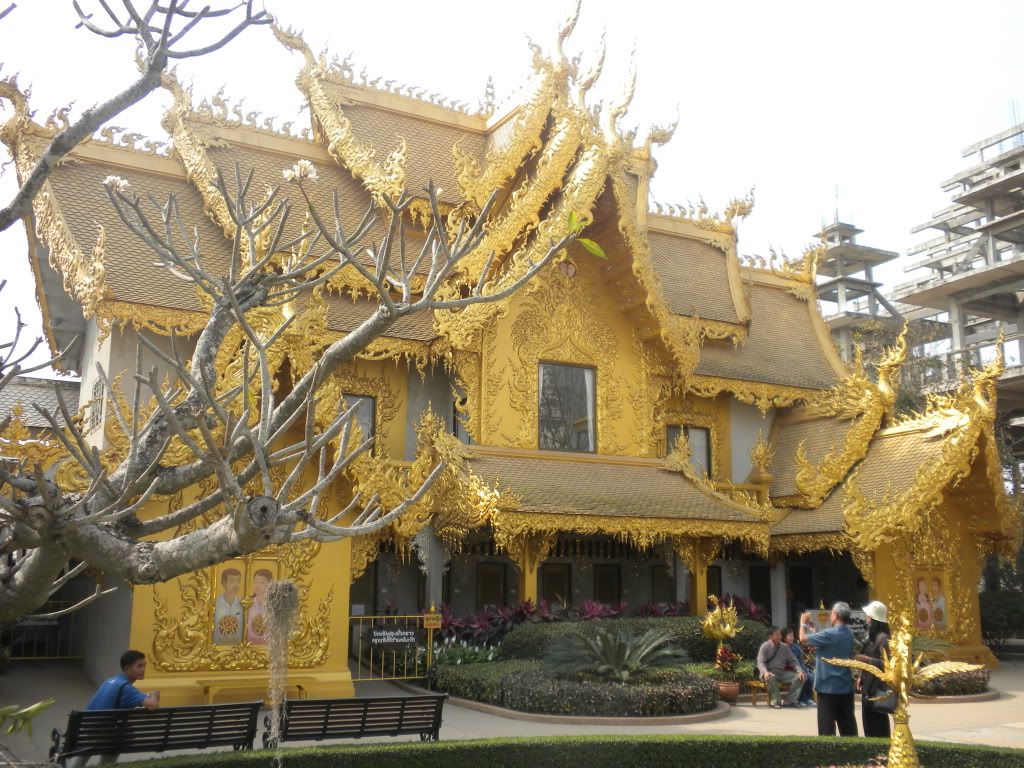
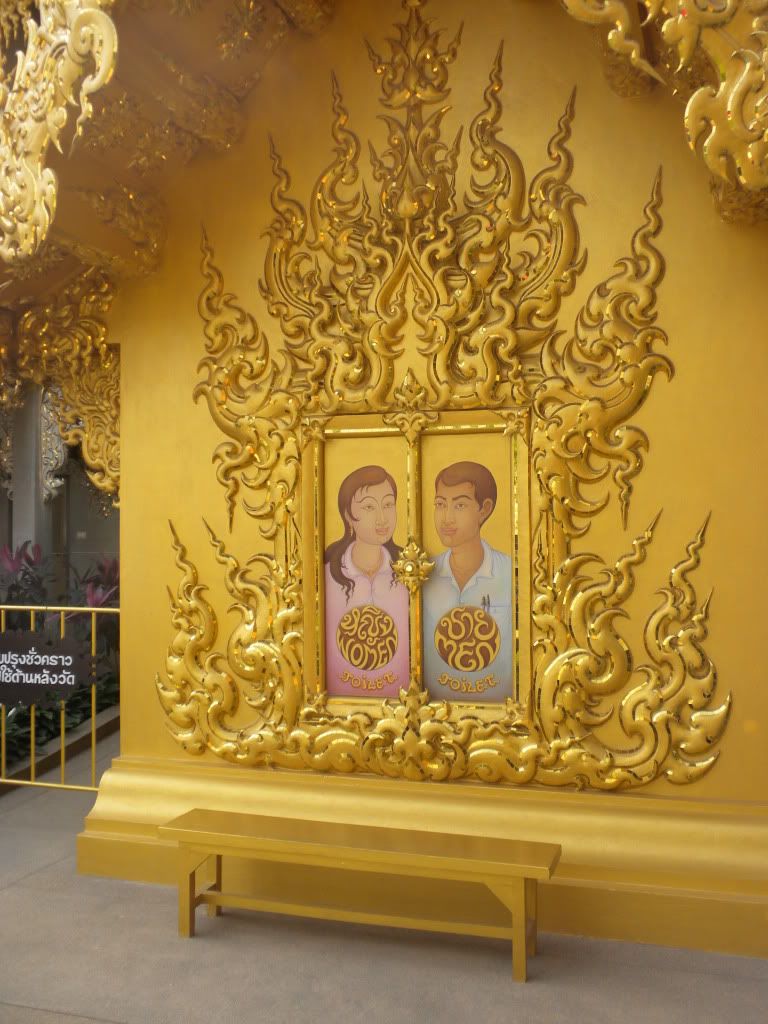
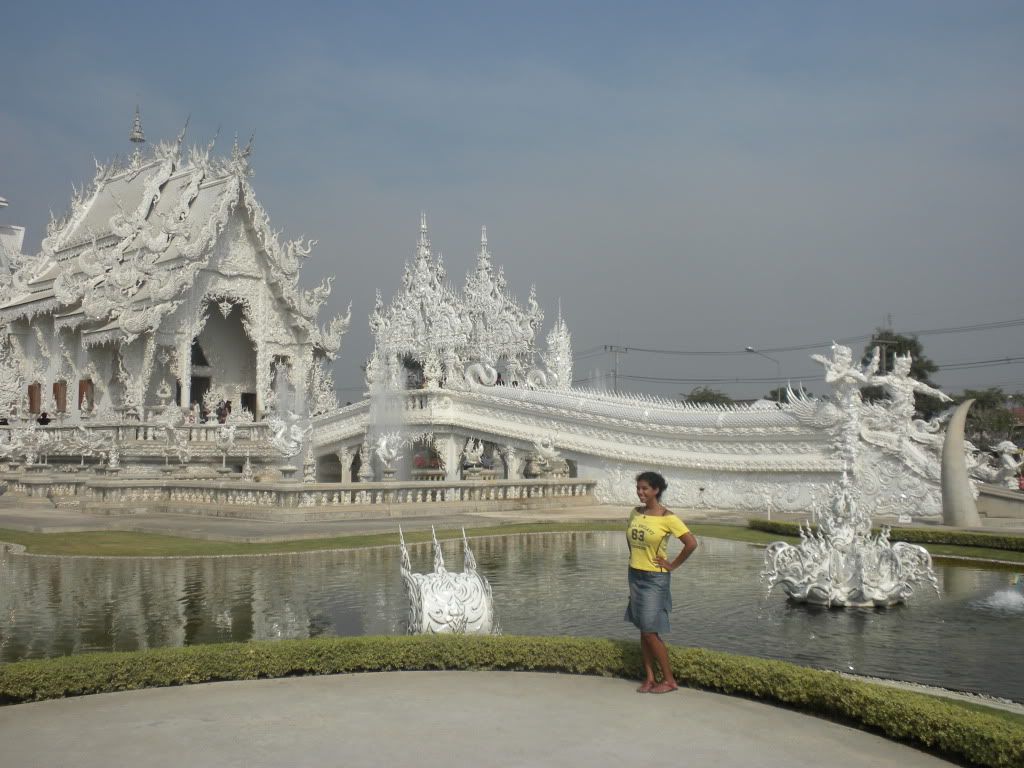
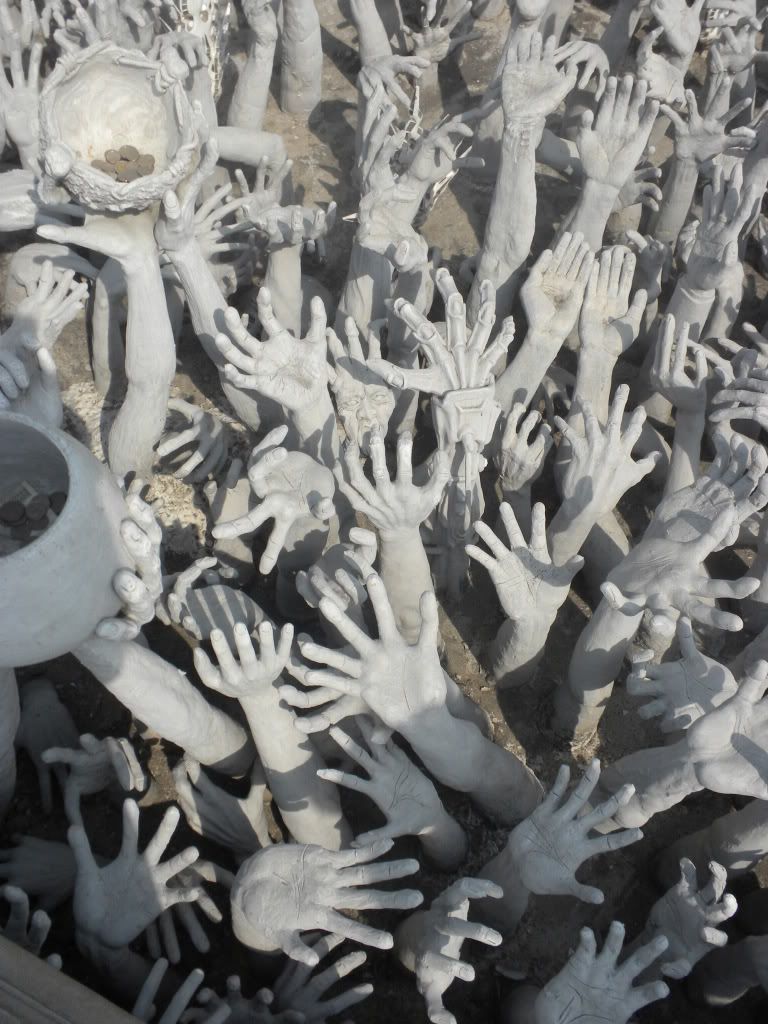
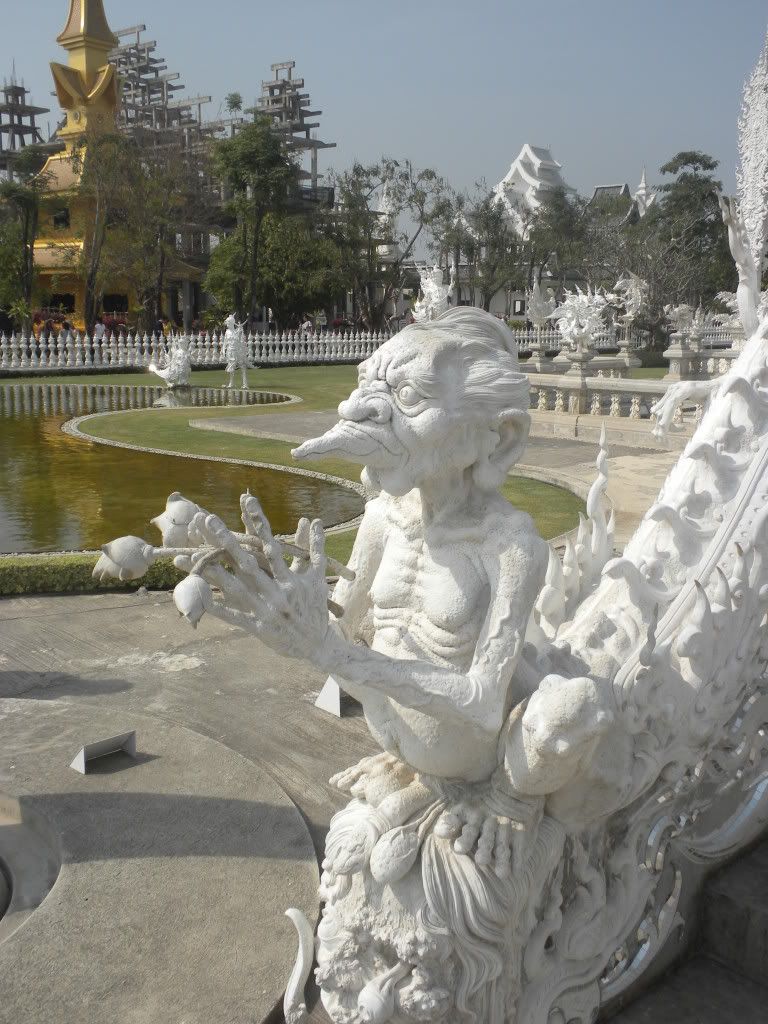

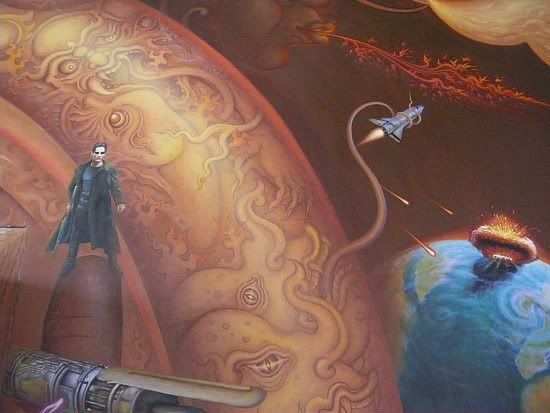
Finally we made it to “The Golden Triangle,” formerly the main location of Thailand’s opium trade; also known as the location where Thailand, Laos and Burma meet. We got into a little boat and got a ride around the area, seeing our first glimpse of Laos. We hopped off the boat and explored a touristy market, sampling some of the strange whiskies on offer. Some had cobras in them, another had a whole armadillo; there was even one with a tiger’s penis! We sampled them but nothing tasted too strange… in fact, they all kinda tasted the same. After a buffet lunch of Burmese food, we went to see the Padong “longneck” women, along with some other hill tribe people at a touristy “camp” set up for them. These camps are quite controversial we learned, with some people calling them “human zoos.”
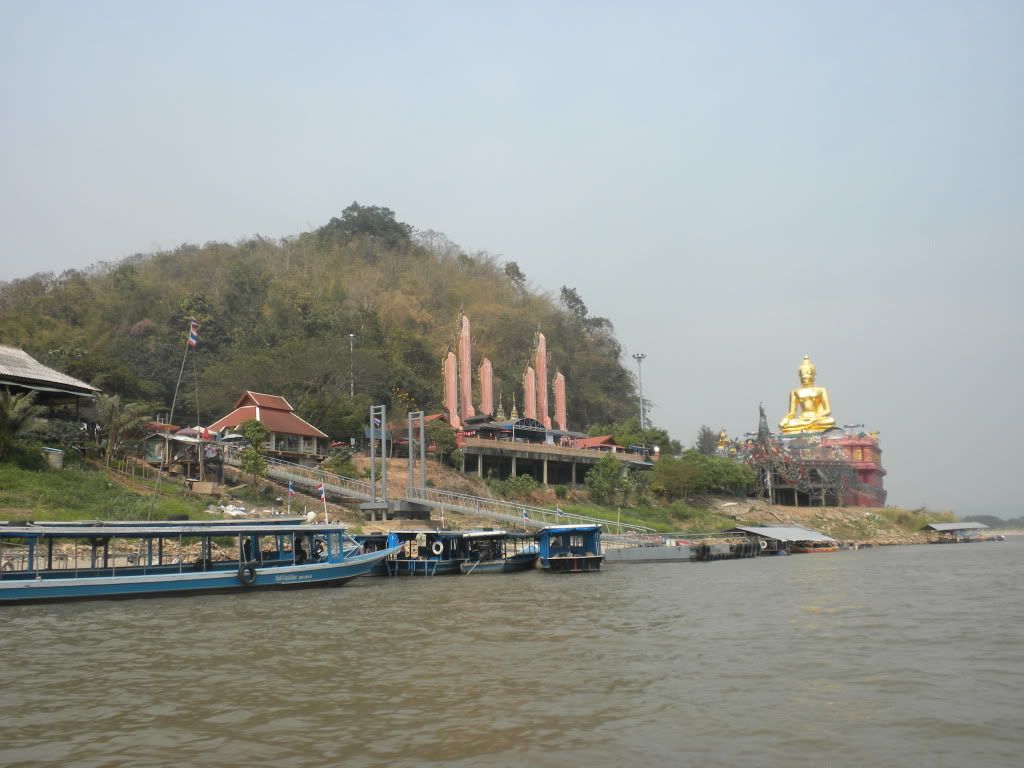
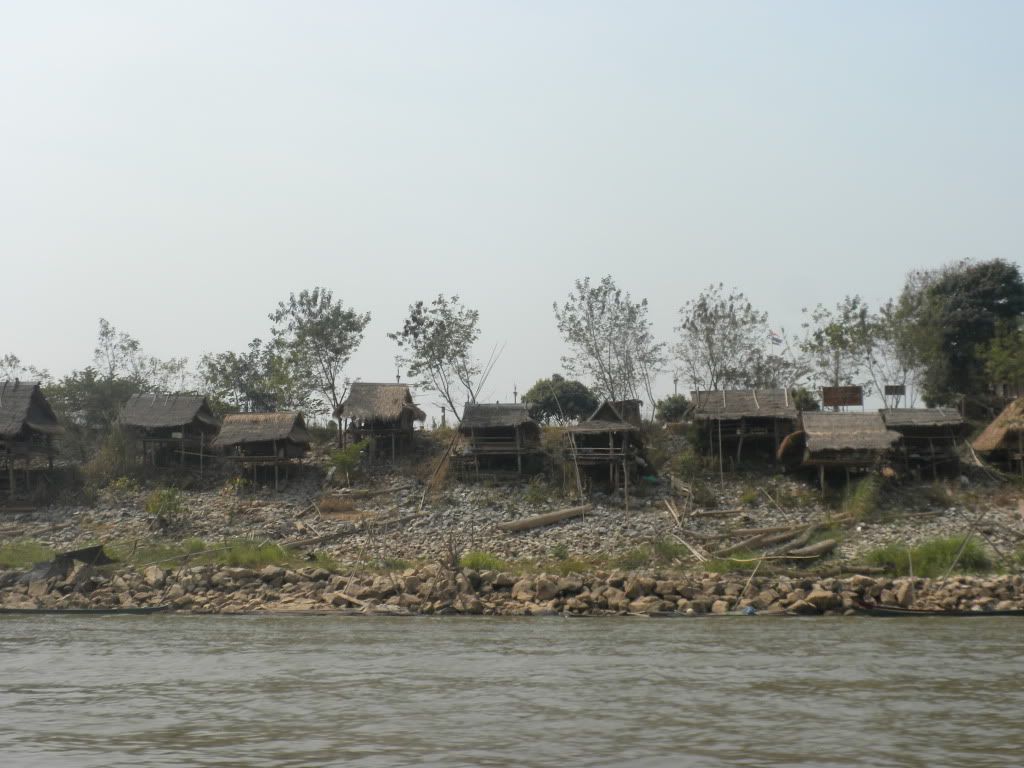

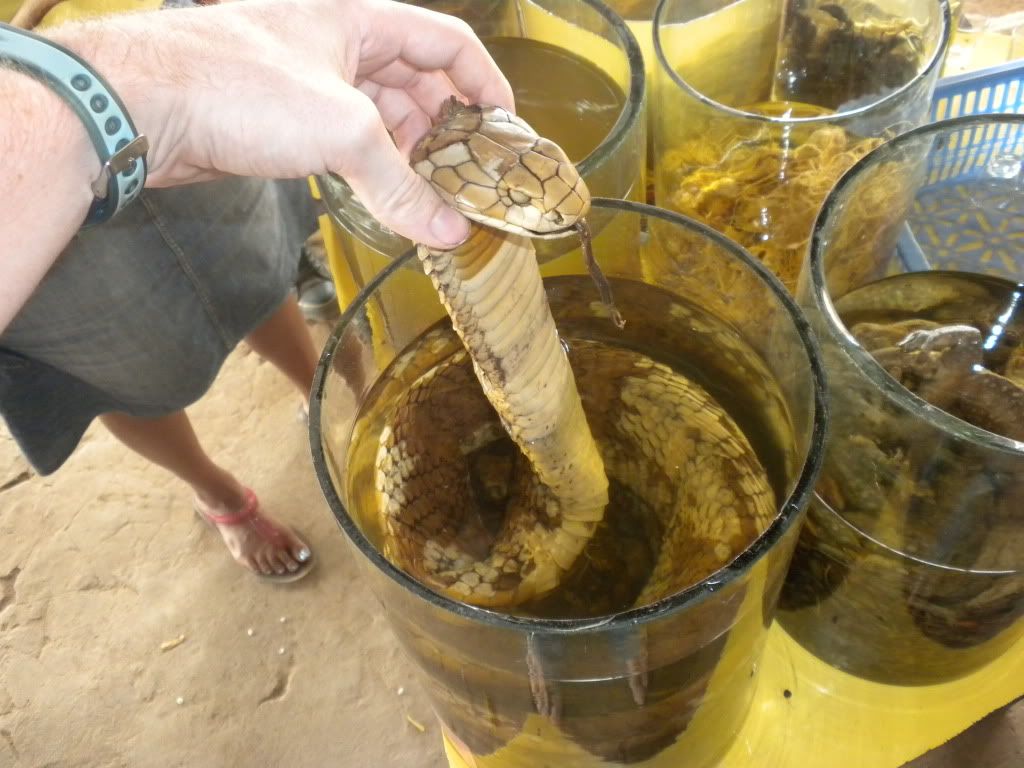
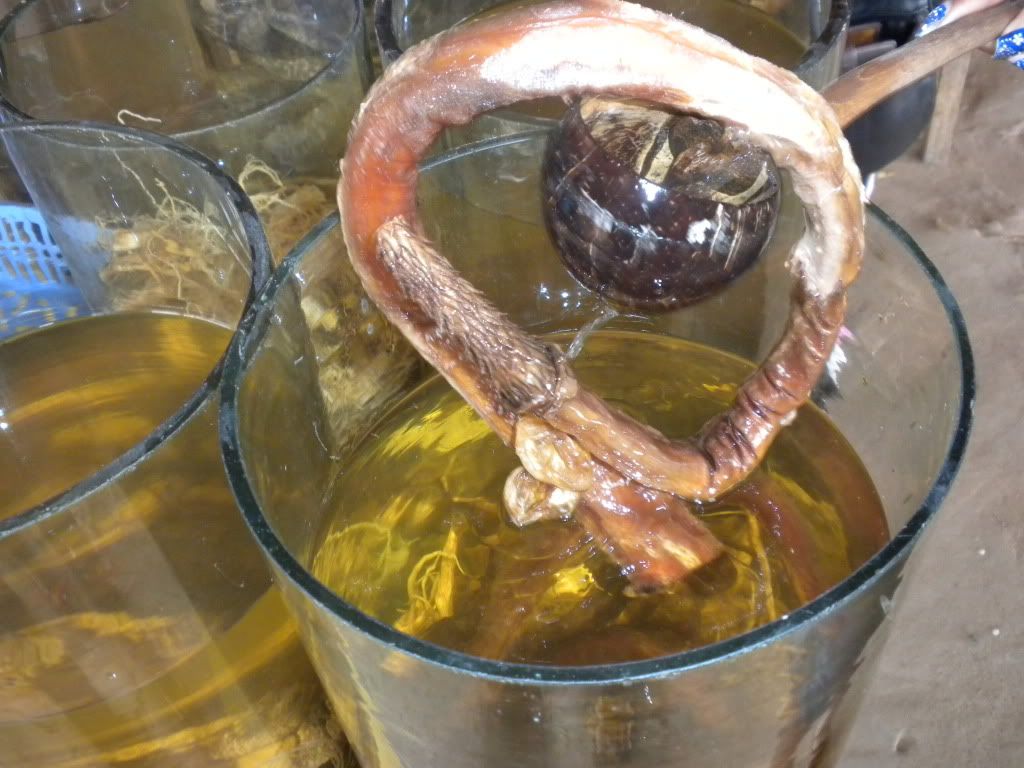
We walked with our guide around the camp, taking pictures and buying crafts from some of the women. First was an Akha woman with awesome headdresses, next we saw a black-toothed Lahu woman chewing her betel nut mixture, and finally the Padong “long-necked” women. These women are famous for their illusion of having long necks (in actuality, their collarbone and rib cage are pushed down giving an appearance of a longer-than-normal neck) and the brass rings forming a “collar” around them. Padong women aren’t allowed to marry outside of their clan, and their only understanding of why they wear the rings is because of tradition. Henk and I heard from the Bidayuh man we stayed with that the rings were originally used to aid the women in carrying heavy baskets of rice on their heads, as neck support. Next we visited with the Karen sub-group people known as the Kayah, who have “big ears,” as their earlobes are stretched out by large earrings and the Mien (or Yao) (wearing their famous fluffy red “scarf”) who keep their Chinese ancestry quite close and practice the highly ceremonial religion of Taoism.

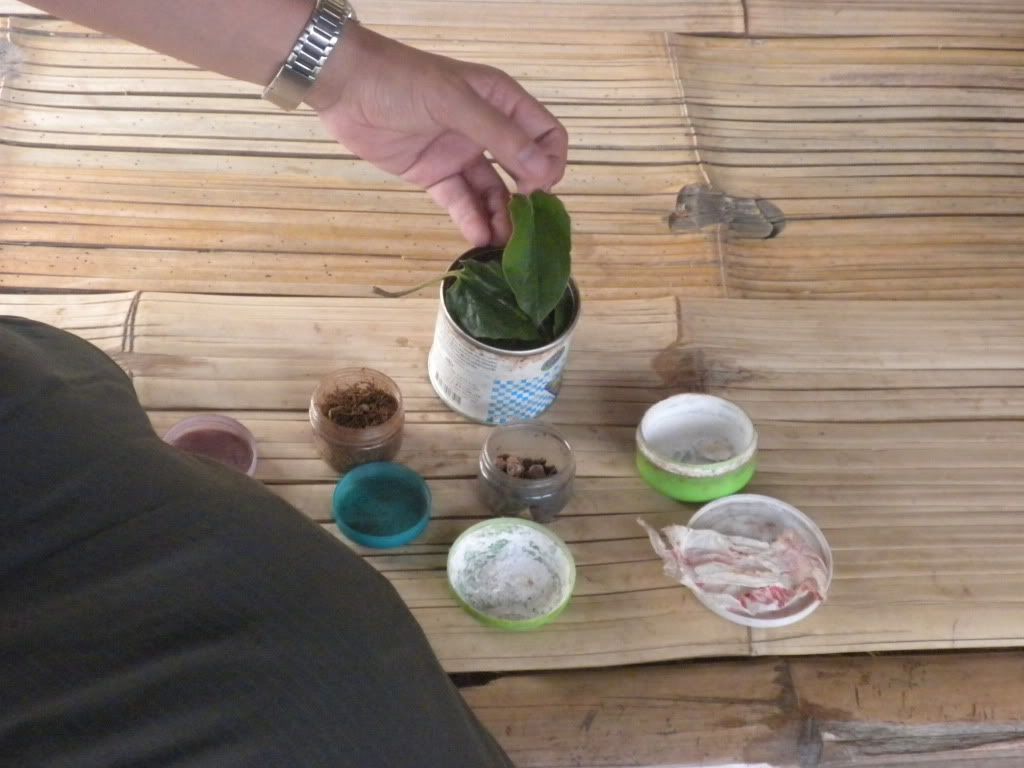
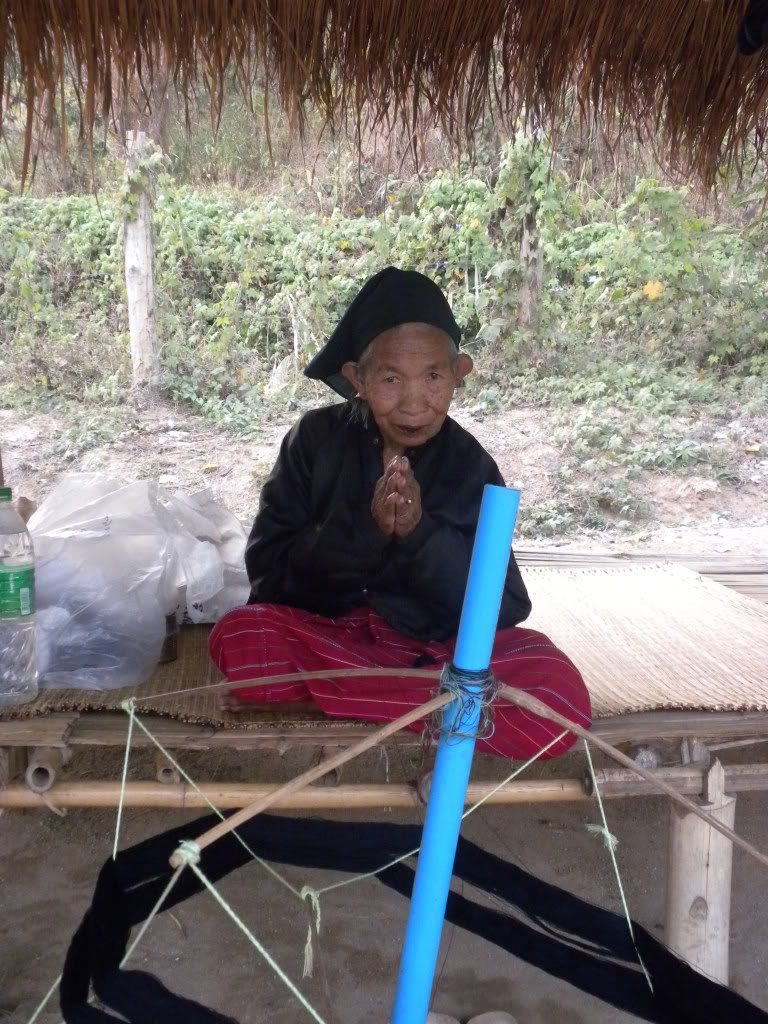
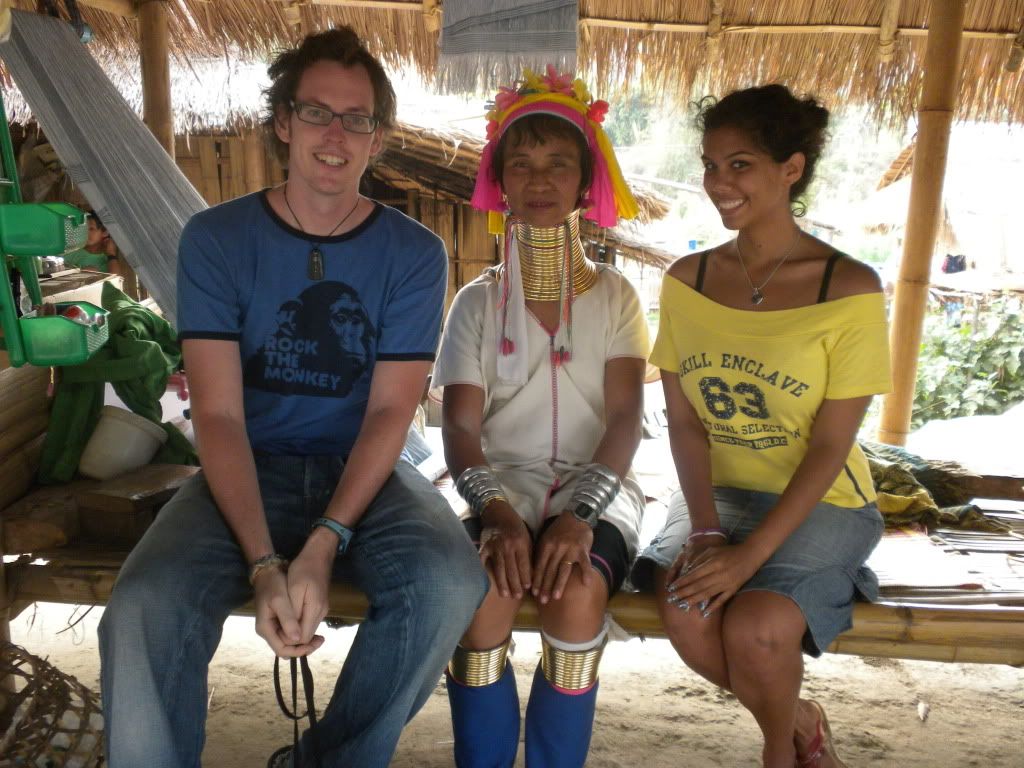
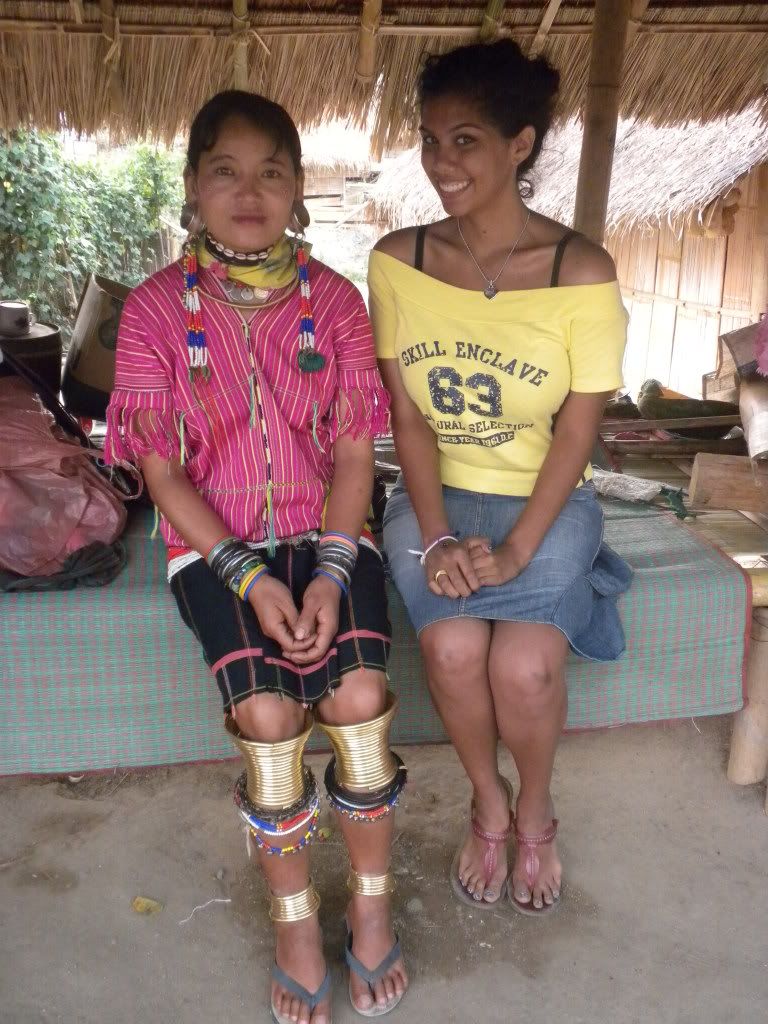
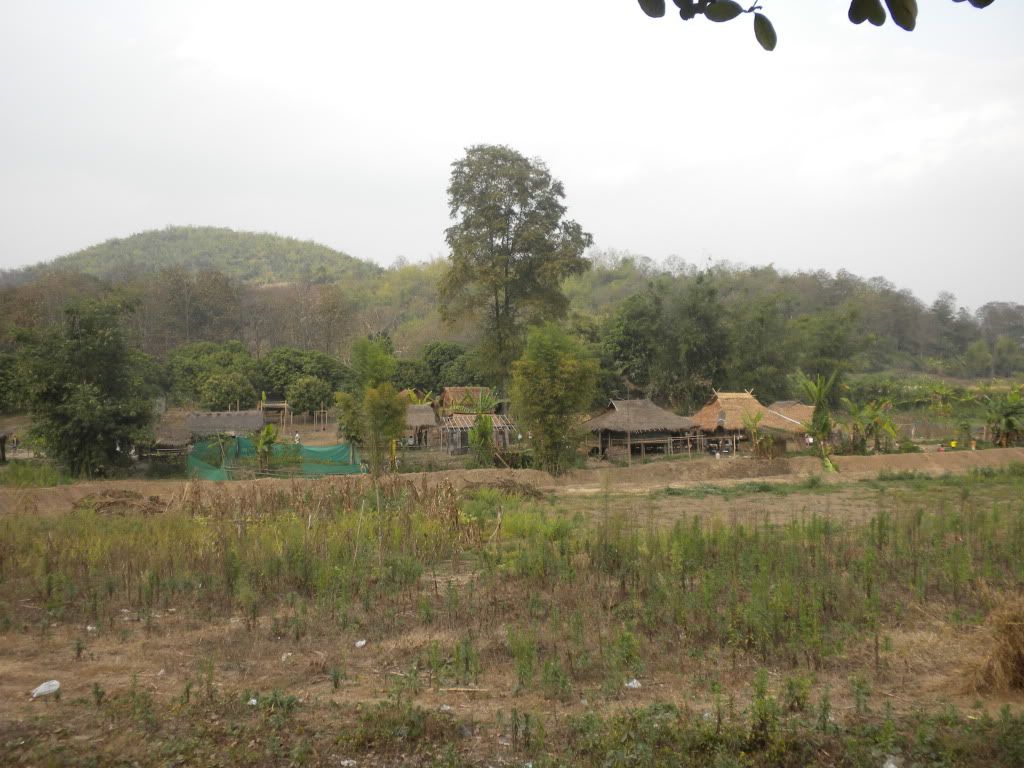
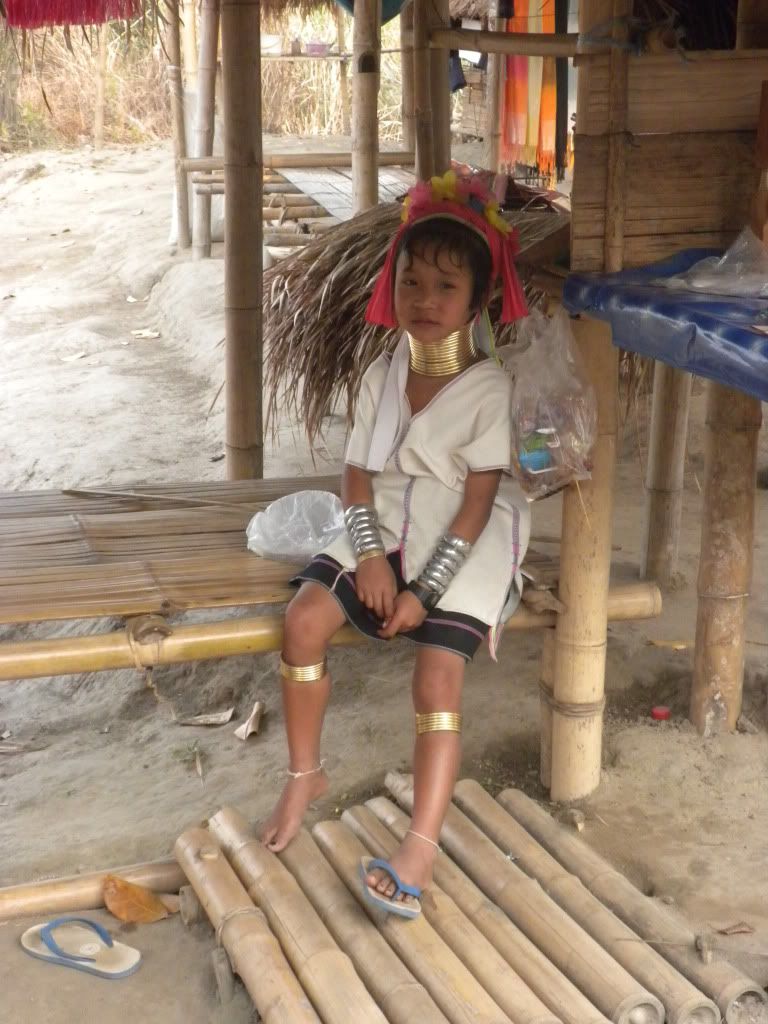
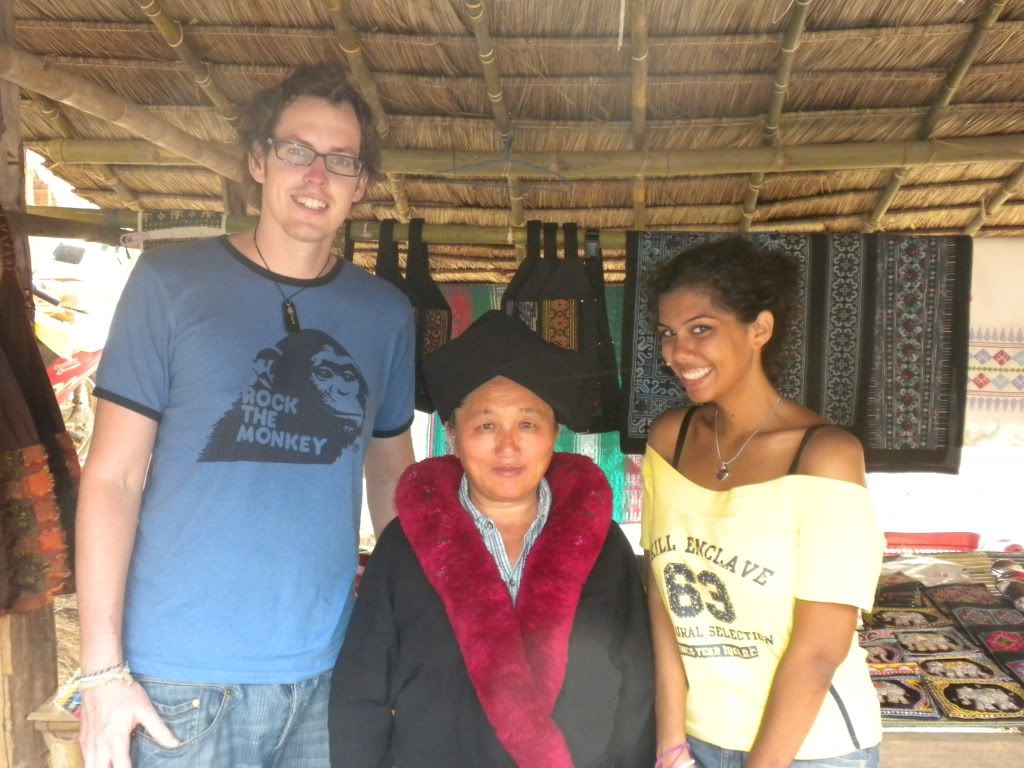
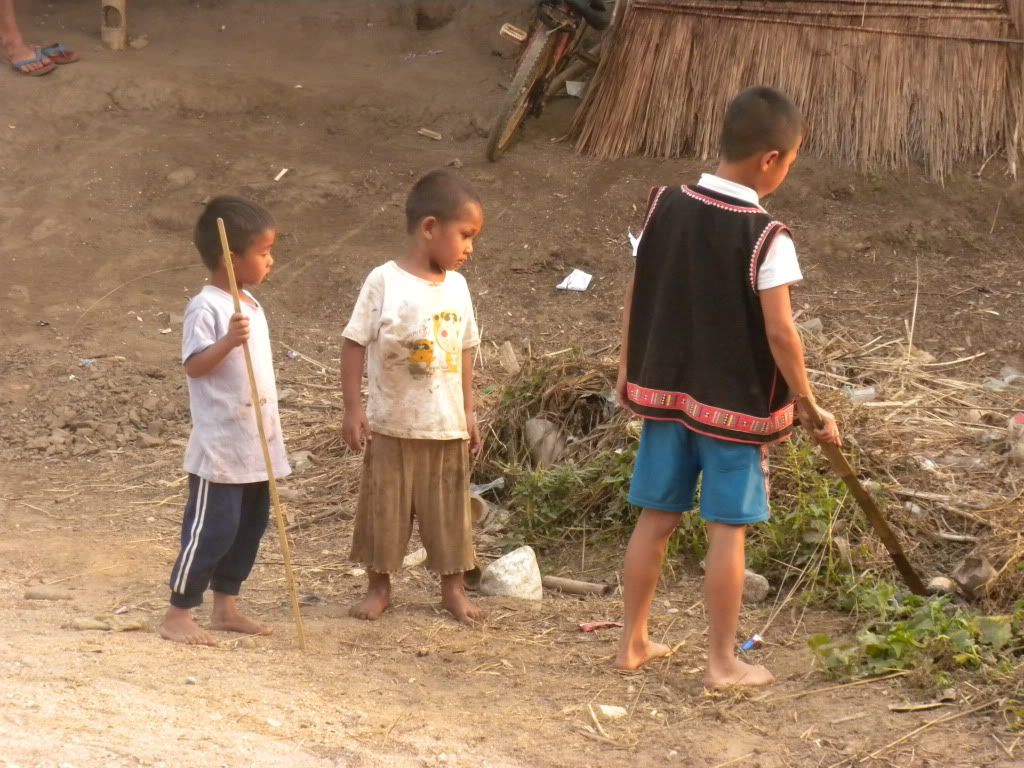
After talking to our guide later, we learned that only certain groups of the hill tribe people (namely those who have lived in Thailand longer than 20 years or so) have citizenship and the rest, who have crossed the border from Burma in the last 20 years, are illegally in the country. Since they are illegal, they don’t have citizenship but they are still allowed to “work” as tourist attractions in camps such as the one we went to. They aren’t allowed to go to the mall, the 7-11, the night market, regular schooling, or basically leave the campground unless they wanted to be deported back to Burma. Obviously in Burma there is a high risk that they will be massacred right away. Therefore the little freedom living on a camp in Thailand amasses for the illegal hill tribe people is still better than instant death for them. We discussed the hill tribe people’s situation with him all the way back to Chiang Mai. We didn’t return until pretty late in the evening and were quite exhausted. We needed our sleep!!
Francesca
